

Compact Muon Solenoid
LHC, CERN
| CMS-PAS-TOP-17-002 | ||
| Measurement of differential cross sections for top quark pair production and associated jets using the lepton+jets final state in proton-proton collisions at 13 TeV | ||
| CMS Collaboration | ||
| September 2017 | ||
| Abstract: Differential and double-differential cross sections for the production of top quark pairs in proton-proton collisions at 13 TeV are measured as a function of kinematic variables of the top quarks and the top quark-antiquark system. In addition, kinematic properties and multiplicities of jets associated with the production of top quark pairs are measured. This analysis is based on data collected by the CMS experiment at the LHC in 2016 corresponding to an integrated luminosity of 35.8 fb−1. The measurements are performed in the lepton+jets decay channels with a single muon or electron and jets in the final state. The differential cross sections are presented at particle level, within a phase space close to the experimental acceptance, and at parton level in the full phase space. The results are compared to several standard model predictions that use different methods and approximations for their calculations. The kinematic properties of the top quarks and the top quark-antiquark system are well described apart from a softer transverse momentum of the top quarks, which has already been observed in previous measurements. The kinematic distributions and multiplicities of jets can be modeled by certain combinations of next-to-leading order calculations and parton shower models. | ||
|
Links:
CDS record (PDF) ;
CADI line (restricted) ;
These preliminary results are superseded in this paper, PRD 97 (2018) 112003. The superseded preliminary plots can be found here. |
||
| Figures | |

png pdf |
Figure 1:
Comparison between the pT (th) at particle and parton level, extracted from the POWHEG+PYTHIA8 simulation. Left : fraction of parton-level top quarks in the same bin at particle level (purity), fraction of particle-level top quarks in the same bin at parton level (stability), ratio of the number of particle- to parton-level top quarks, and fraction of events with a particle-level top quark pair that are not considered as signal events at parton level. Right : bin migrations between particle and parton level. The pT range of the bins can be taken from the left panel. Each column is normalized to the number of events per column at parton level in the full phase space. |

png pdf |
Figure 1-a:
Comparison between the pT (th) at particle and parton level, extracted from the POWHEG+PYTHIA8 simulation. Left : fraction of parton-level top quarks in the same bin at particle level (purity), fraction of particle-level top quarks in the same bin at parton level (stability), ratio of the number of particle- to parton-level top quarks, and fraction of events with a particle-level top quark pair that are not considered as signal events at parton level. Right : bin migrations between particle and parton level. The pT range of the bins can be taken from the left panel. Each column is normalized to the number of events per column at parton level in the full phase space. |

png pdf |
Figure 1-b:
Comparison between the pT (th) at particle and parton level, extracted from the POWHEG+PYTHIA8 simulation. Left : fraction of parton-level top quarks in the same bin at particle level (purity), fraction of particle-level top quarks in the same bin at parton level (stability), ratio of the number of particle- to parton-level top quarks, and fraction of events with a particle-level top quark pair that are not considered as signal events at parton level. Right : bin migrations between particle and parton level. The pT range of the bins can be taken from the left panel. Each column is normalized to the number of events per column at parton level in the full phase space. |

png pdf |
Figure 2:
Top: normalized two-dimensional mass distribution of the correctly reconstructed hadronically decaying W bosons M(W) and the correctly reconstructed top quarks M(th) for the parton- (left) and the particle- (right) level measurements. The predictions of the other contributions are taken from the simulation. Bottom: normalized distributions of the distance Dν,min for correctly and wrongly selected b jets from the leptonically decaying top quarks. The distributions are taken from the POWHEG+PYTHIA8 tˉt simulation. |

png pdf |
Figure 2-a:
Top: normalized two-dimensional mass distribution of the correctly reconstructed hadronically decaying W bosons M(W) and the correctly reconstructed top quarks M(th) for the parton- (left) and the particle- (right) level measurements. The predictions of the other contributions are taken from the simulation. Bottom: normalized distributions of the distance Dν,min for correctly and wrongly selected b jets from the leptonically decaying top quarks. The distributions are taken from the POWHEG+PYTHIA8 tˉt simulation. |

png pdf |
Figure 2-b:
Top: normalized two-dimensional mass distribution of the correctly reconstructed hadronically decaying W bosons M(W) and the correctly reconstructed top quarks M(th) for the parton- (left) and the particle- (right) level measurements. The predictions of the other contributions are taken from the simulation. Bottom: normalized distributions of the distance Dν,min for correctly and wrongly selected b jets from the leptonically decaying top quarks. The distributions are taken from the POWHEG+PYTHIA8 tˉt simulation. |
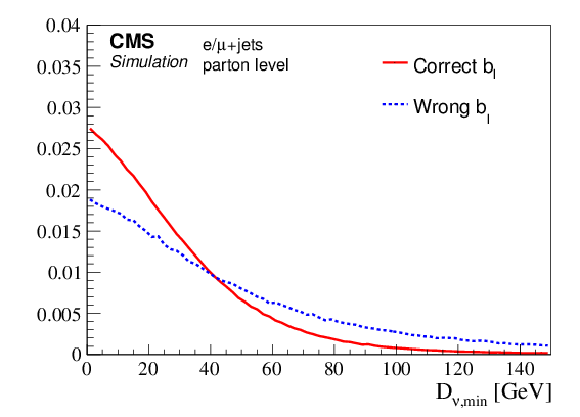
png pdf |
Figure 2-c:
Top: normalized two-dimensional mass distribution of the correctly reconstructed hadronically decaying W bosons M(W) and the correctly reconstructed top quarks M(th) for the parton- (left) and the particle- (right) level measurements. The predictions of the other contributions are taken from the simulation. Bottom: normalized distributions of the distance Dν,min for correctly and wrongly selected b jets from the leptonically decaying top quarks. The distributions are taken from the POWHEG+PYTHIA8 tˉt simulation. |

png pdf |
Figure 2-d:
Top: normalized two-dimensional mass distribution of the correctly reconstructed hadronically decaying W bosons M(W) and the correctly reconstructed top quarks M(th) for the parton- (left) and the particle- (right) level measurements. The predictions of the other contributions are taken from the simulation. Bottom: normalized distributions of the distance Dν,min for correctly and wrongly selected b jets from the leptonically decaying top quarks. The distributions are taken from the POWHEG+PYTHIA8 tˉt simulation. |

png pdf |
Figure 3:
Reconstruction efficiency of the tˉt system as a function of the number of additional jets for the parton- (left) and particle- (right) level measurements. The efficiencies are calculated based on the simulations with POWHEG+PYTHIA8 (P8), POWHEG+HERWIG++ (H++), and MG5_aMC@NLO +PYTHIA8. The efficiencies are shown with statistical uncertainties depending on the simulation. |

png pdf |
Figure 3-a:
Reconstruction efficiency of the tˉt system as a function of the number of additional jets for the parton- (left) and particle- (right) level measurements. The efficiencies are calculated based on the simulations with POWHEG+PYTHIA8 (P8), POWHEG+HERWIG++ (H++), and MG5_aMC@NLO +PYTHIA8. The efficiencies are shown with statistical uncertainties depending on the simulation. |
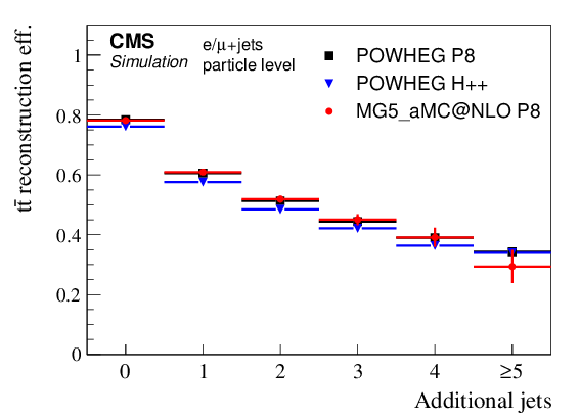
png pdf |
Figure 3-b:
Reconstruction efficiency of the tˉt system as a function of the number of additional jets for the parton- (left) and particle- (right) level measurements. The efficiencies are calculated based on the simulations with POWHEG+PYTHIA8 (P8), POWHEG+HERWIG++ (H++), and MG5_aMC@NLO +PYTHIA8. The efficiencies are shown with statistical uncertainties depending on the simulation. |

png pdf |
Figure 4:
Distribution of the negative log-likelihood for the selected best permutation in the parton- (left) and the particle- (right) level measurements in data and simulations. The simulation of POWHEG+PYTHIA8 is used to describe the tˉt production. The contribution of multijet, DY, and W boson events is extracted from the data (cf. Section 7). Experimental (cf. Section 9) and statistical uncertainties (hatched area) are shown for the total simulated yield, which is normalized to the measured integrated luminosity of the data. The data points are shown with statistical uncertainties. The ratios of data to the sum of the expected yields are provided at the bottom of each panel. |

png pdf |
Figure 4-a:
Distribution of the negative log-likelihood for the selected best permutation in the parton- (left) and the particle- (right) level measurements in data and simulations. The simulation of POWHEG+PYTHIA8 is used to describe the tˉt production. The contribution of multijet, DY, and W boson events is extracted from the data (cf. Section 7). Experimental (cf. Section 9) and statistical uncertainties (hatched area) are shown for the total simulated yield, which is normalized to the measured integrated luminosity of the data. The data points are shown with statistical uncertainties. The ratios of data to the sum of the expected yields are provided at the bottom of each panel. |

png pdf |
Figure 4-b:
Distribution of the negative log-likelihood for the selected best permutation in the parton- (left) and the particle- (right) level measurements in data and simulations. The simulation of POWHEG+PYTHIA8 is used to describe the tˉt production. The contribution of multijet, DY, and W boson events is extracted from the data (cf. Section 7). Experimental (cf. Section 9) and statistical uncertainties (hatched area) are shown for the total simulated yield, which is normalized to the measured integrated luminosity of the data. The data points are shown with statistical uncertainties. The ratios of data to the sum of the expected yields are provided at the bottom of each panel. |

png pdf |
Figure 5:
Comparisons of the reconstructed distributions of the pT of jets as identified by the tˉt reconstruction algorithm. The simulation of POWHEG+PYTHIA8 is used to describe the tˉt production. The contribution of multijet, DY, and W boson events is extracted from the data (cf. Section 7). Experimental (cf. Section 9) and statistical uncertainties (hatched area) are shown for the total simulated yield, which is normalized according to the measured integrated luminosity of the data. The data points are shown with statistical uncertainties. The ratios of data to the expected yields are given at the bottom of each panel. |

png pdf |
Figure 5-a:
Comparisons of the reconstructed distributions of the pT of jets as identified by the tˉt reconstruction algorithm. The simulation of POWHEG+PYTHIA8 is used to describe the tˉt production. The contribution of multijet, DY, and W boson events is extracted from the data (cf. Section 7). Experimental (cf. Section 9) and statistical uncertainties (hatched area) are shown for the total simulated yield, which is normalized according to the measured integrated luminosity of the data. The data points are shown with statistical uncertainties. The ratios of data to the expected yields are given at the bottom of each panel. |

png pdf |
Figure 5-b:
Comparisons of the reconstructed distributions of the pT of jets as identified by the tˉt reconstruction algorithm. The simulation of POWHEG+PYTHIA8 is used to describe the tˉt production. The contribution of multijet, DY, and W boson events is extracted from the data (cf. Section 7). Experimental (cf. Section 9) and statistical uncertainties (hatched area) are shown for the total simulated yield, which is normalized according to the measured integrated luminosity of the data. The data points are shown with statistical uncertainties. The ratios of data to the expected yields are given at the bottom of each panel. |
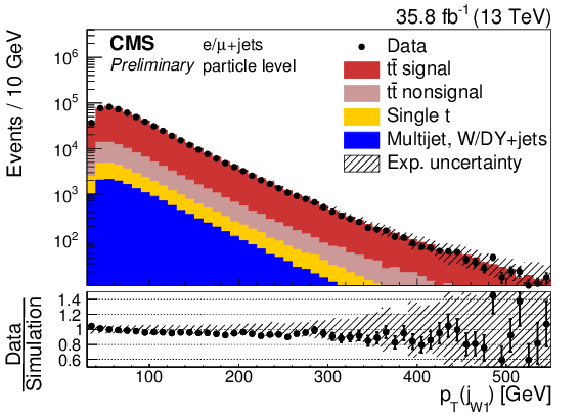
png pdf |
Figure 5-c:
Comparisons of the reconstructed distributions of the pT of jets as identified by the tˉt reconstruction algorithm. The simulation of POWHEG+PYTHIA8 is used to describe the tˉt production. The contribution of multijet, DY, and W boson events is extracted from the data (cf. Section 7). Experimental (cf. Section 9) and statistical uncertainties (hatched area) are shown for the total simulated yield, which is normalized according to the measured integrated luminosity of the data. The data points are shown with statistical uncertainties. The ratios of data to the expected yields are given at the bottom of each panel. |

png pdf |
Figure 5-d:
Comparisons of the reconstructed distributions of the pT of jets as identified by the tˉt reconstruction algorithm. The simulation of POWHEG+PYTHIA8 is used to describe the tˉt production. The contribution of multijet, DY, and W boson events is extracted from the data (cf. Section 7). Experimental (cf. Section 9) and statistical uncertainties (hatched area) are shown for the total simulated yield, which is normalized according to the measured integrated luminosity of the data. The data points are shown with statistical uncertainties. The ratios of data to the expected yields are given at the bottom of each panel. |

png pdf |
Figure 5-e:
Comparisons of the reconstructed distributions of the pT of jets as identified by the tˉt reconstruction algorithm. The simulation of POWHEG+PYTHIA8 is used to describe the tˉt production. The contribution of multijet, DY, and W boson events is extracted from the data (cf. Section 7). Experimental (cf. Section 9) and statistical uncertainties (hatched area) are shown for the total simulated yield, which is normalized according to the measured integrated luminosity of the data. The data points are shown with statistical uncertainties. The ratios of data to the expected yields are given at the bottom of each panel. |

png pdf |
Figure 5-f:
Comparisons of the reconstructed distributions of the pT of jets as identified by the tˉt reconstruction algorithm. The simulation of POWHEG+PYTHIA8 is used to describe the tˉt production. The contribution of multijet, DY, and W boson events is extracted from the data (cf. Section 7). Experimental (cf. Section 9) and statistical uncertainties (hatched area) are shown for the total simulated yield, which is normalized according to the measured integrated luminosity of the data. The data points are shown with statistical uncertainties. The ratios of data to the expected yields are given at the bottom of each panel. |

png pdf |
Figure 5-g:
Comparisons of the reconstructed distributions of the pT of jets as identified by the tˉt reconstruction algorithm. The simulation of POWHEG+PYTHIA8 is used to describe the tˉt production. The contribution of multijet, DY, and W boson events is extracted from the data (cf. Section 7). Experimental (cf. Section 9) and statistical uncertainties (hatched area) are shown for the total simulated yield, which is normalized according to the measured integrated luminosity of the data. The data points are shown with statistical uncertainties. The ratios of data to the expected yields are given at the bottom of each panel. |

png pdf |
Figure 5-h:
Comparisons of the reconstructed distributions of the pT of jets as identified by the tˉt reconstruction algorithm. The simulation of POWHEG+PYTHIA8 is used to describe the tˉt production. The contribution of multijet, DY, and W boson events is extracted from the data (cf. Section 7). Experimental (cf. Section 9) and statistical uncertainties (hatched area) are shown for the total simulated yield, which is normalized according to the measured integrated luminosity of the data. The data points are shown with statistical uncertainties. The ratios of data to the expected yields are given at the bottom of each panel. |

png pdf |
Figure 6:
Comparisons of the reconstructed pT (top) and <y> (bottom) in data and simulations for the parton (left) and the particle (right) level. The simulation of POWHEG+PYTHIA8 is used to describe the tˉt production. The contribution of multijet, DY, and W boson events is extracted from the data (cf. Section 7). Experimental (cf. Section 9) and statistical uncertainties (hatched area) are shown for the total simulated yield, which is normalized according to the measured integrated luminosity of the data. The data points are shown with statistical uncertainties. The ratios of data to the expected yields are given at the bottom of each panel. |

png pdf |
Figure 6-a:
Comparisons of the reconstructed pT (top) and <y> (bottom) in data and simulations for the parton (left) and the particle (right) level. The simulation of POWHEG+PYTHIA8 is used to describe the tˉt production. The contribution of multijet, DY, and W boson events is extracted from the data (cf. Section 7). Experimental (cf. Section 9) and statistical uncertainties (hatched area) are shown for the total simulated yield, which is normalized according to the measured integrated luminosity of the data. The data points are shown with statistical uncertainties. The ratios of data to the expected yields are given at the bottom of each panel. |

png pdf |
Figure 6-b:
Comparisons of the reconstructed pT (top) and <y> (bottom) in data and simulations for the parton (left) and the particle (right) level. The simulation of POWHEG+PYTHIA8 is used to describe the tˉt production. The contribution of multijet, DY, and W boson events is extracted from the data (cf. Section 7). Experimental (cf. Section 9) and statistical uncertainties (hatched area) are shown for the total simulated yield, which is normalized according to the measured integrated luminosity of the data. The data points are shown with statistical uncertainties. The ratios of data to the expected yields are given at the bottom of each panel. |

png pdf |
Figure 6-c:
Comparisons of the reconstructed pT (top) and <y> (bottom) in data and simulations for the parton (left) and the particle (right) level. The simulation of POWHEG+PYTHIA8 is used to describe the tˉt production. The contribution of multijet, DY, and W boson events is extracted from the data (cf. Section 7). Experimental (cf. Section 9) and statistical uncertainties (hatched area) are shown for the total simulated yield, which is normalized according to the measured integrated luminosity of the data. The data points are shown with statistical uncertainties. The ratios of data to the expected yields are given at the bottom of each panel. |

png pdf |
Figure 6-d:
Comparisons of the reconstructed pT (top) and <y> (bottom) in data and simulations for the parton (left) and the particle (right) level. The simulation of POWHEG+PYTHIA8 is used to describe the tˉt production. The contribution of multijet, DY, and W boson events is extracted from the data (cf. Section 7). Experimental (cf. Section 9) and statistical uncertainties (hatched area) are shown for the total simulated yield, which is normalized according to the measured integrated luminosity of the data. The data points are shown with statistical uncertainties. The ratios of data to the expected yields are given at the bottom of each panel. |

png pdf |
Figure 7:
Comparisons of the reconstructed distributions of pT (tˉt) (top) and M(tˉt) (middle) for the parton- (left) and the particle- (right) level measurements in data and simulations. Bottom: distributions of <y(tˉt)> (left) and the number of additional jets (right). The simulation of POWHEG+PYTHIA8 is used to describe the tˉt production. The contribution of multijet, DY, and W boson events is extracted from the data (cf. Section 7). Experimental (cf. Section 9) and statistical uncertainties (hatched area) are shown for the total simulated yield, which is normalized according to the measured integrated luminosity of the data. The data points are shown with statistical uncertainties. The ratios of data to the expected yields are given at the bottom of each panel. |

png pdf |
Figure 7-a:
Comparisons of the reconstructed distributions of pT (tˉt) (top) and M(tˉt) (middle) for the parton- (left) and the particle- (right) level measurements in data and simulations. Bottom: distributions of <y(tˉt)> (left) and the number of additional jets (right). The simulation of POWHEG+PYTHIA8 is used to describe the tˉt production. The contribution of multijet, DY, and W boson events is extracted from the data (cf. Section 7). Experimental (cf. Section 9) and statistical uncertainties (hatched area) are shown for the total simulated yield, which is normalized according to the measured integrated luminosity of the data. The data points are shown with statistical uncertainties. The ratios of data to the expected yields are given at the bottom of each panel. |

png pdf |
Figure 7-b:
Comparisons of the reconstructed distributions of pT (tˉt) (top) and M(tˉt) (middle) for the parton- (left) and the particle- (right) level measurements in data and simulations. Bottom: distributions of <y(tˉt)> (left) and the number of additional jets (right). The simulation of POWHEG+PYTHIA8 is used to describe the tˉt production. The contribution of multijet, DY, and W boson events is extracted from the data (cf. Section 7). Experimental (cf. Section 9) and statistical uncertainties (hatched area) are shown for the total simulated yield, which is normalized according to the measured integrated luminosity of the data. The data points are shown with statistical uncertainties. The ratios of data to the expected yields are given at the bottom of each panel. |

png pdf |
Figure 7-c:
Comparisons of the reconstructed distributions of pT (tˉt) (top) and M(tˉt) (middle) for the parton- (left) and the particle- (right) level measurements in data and simulations. Bottom: distributions of <y(tˉt)> (left) and the number of additional jets (right). The simulation of POWHEG+PYTHIA8 is used to describe the tˉt production. The contribution of multijet, DY, and W boson events is extracted from the data (cf. Section 7). Experimental (cf. Section 9) and statistical uncertainties (hatched area) are shown for the total simulated yield, which is normalized according to the measured integrated luminosity of the data. The data points are shown with statistical uncertainties. The ratios of data to the expected yields are given at the bottom of each panel. |

png pdf |
Figure 7-d:
Comparisons of the reconstructed distributions of pT (tˉt) (top) and M(tˉt) (middle) for the parton- (left) and the particle- (right) level measurements in data and simulations. Bottom: distributions of <y(tˉt)> (left) and the number of additional jets (right). The simulation of POWHEG+PYTHIA8 is used to describe the tˉt production. The contribution of multijet, DY, and W boson events is extracted from the data (cf. Section 7). Experimental (cf. Section 9) and statistical uncertainties (hatched area) are shown for the total simulated yield, which is normalized according to the measured integrated luminosity of the data. The data points are shown with statistical uncertainties. The ratios of data to the expected yields are given at the bottom of each panel. |
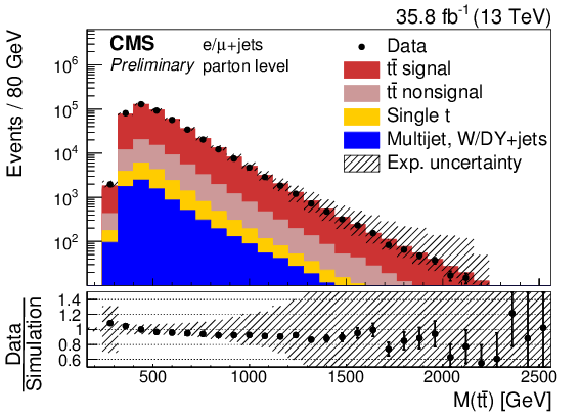
png pdf |
Figure 7-e:
Comparisons of the reconstructed distributions of pT (tˉt) (top) and M(tˉt) (middle) for the parton- (left) and the particle- (right) level measurements in data and simulations. Bottom: distributions of <y(tˉt)> (left) and the number of additional jets (right). The simulation of POWHEG+PYTHIA8 is used to describe the tˉt production. The contribution of multijet, DY, and W boson events is extracted from the data (cf. Section 7). Experimental (cf. Section 9) and statistical uncertainties (hatched area) are shown for the total simulated yield, which is normalized according to the measured integrated luminosity of the data. The data points are shown with statistical uncertainties. The ratios of data to the expected yields are given at the bottom of each panel. |

png pdf |
Figure 7-f:
Comparisons of the reconstructed distributions of pT (tˉt) (top) and M(tˉt) (middle) for the parton- (left) and the particle- (right) level measurements in data and simulations. Bottom: distributions of <y(tˉt)> (left) and the number of additional jets (right). The simulation of POWHEG+PYTHIA8 is used to describe the tˉt production. The contribution of multijet, DY, and W boson events is extracted from the data (cf. Section 7). Experimental (cf. Section 9) and statistical uncertainties (hatched area) are shown for the total simulated yield, which is normalized according to the measured integrated luminosity of the data. The data points are shown with statistical uncertainties. The ratios of data to the expected yields are given at the bottom of each panel. |

png pdf |
Figure 8:
Migration studies of the parton (top) and particle (bottom) level measurements of pT (th), extracted from the POWHEG+PYTHIA8 simulation. Left : purity, stability, and efficiency per bin. Right : bin migrations between detector and parton (particle) level. The pT range of the bins can be taken from the left panels. Each column is normalized to the number of events per column at parton (particle) level in the finally measured phase space. |

png pdf |
Figure 8-a:
Migration studies of the parton (top) and particle (bottom) level measurements of pT (th), extracted from the POWHEG+PYTHIA8 simulation. Left : purity, stability, and efficiency per bin. Right : bin migrations between detector and parton (particle) level. The pT range of the bins can be taken from the left panels. Each column is normalized to the number of events per column at parton (particle) level in the finally measured phase space. |

png pdf |
Figure 8-b:
Migration studies of the parton (top) and particle (bottom) level measurements of pT (th), extracted from the POWHEG+PYTHIA8 simulation. Left : purity, stability, and efficiency per bin. Right : bin migrations between detector and parton (particle) level. The pT range of the bins can be taken from the left panels. Each column is normalized to the number of events per column at parton (particle) level in the finally measured phase space. |
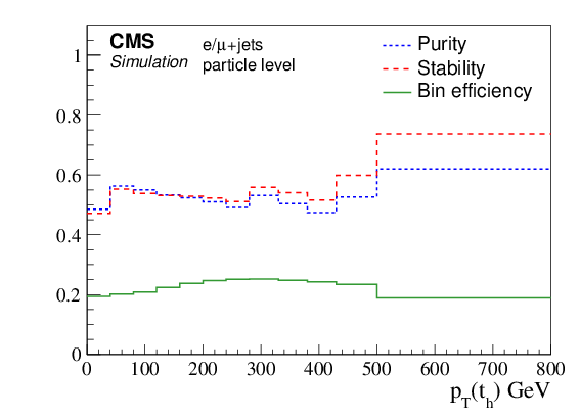
png pdf |
Figure 8-c:
Migration studies of the parton (top) and particle (bottom) level measurements of pT (th), extracted from the POWHEG+PYTHIA8 simulation. Left : purity, stability, and efficiency per bin. Right : bin migrations between detector and parton (particle) level. The pT range of the bins can be taken from the left panels. Each column is normalized to the number of events per column at parton (particle) level in the finally measured phase space. |
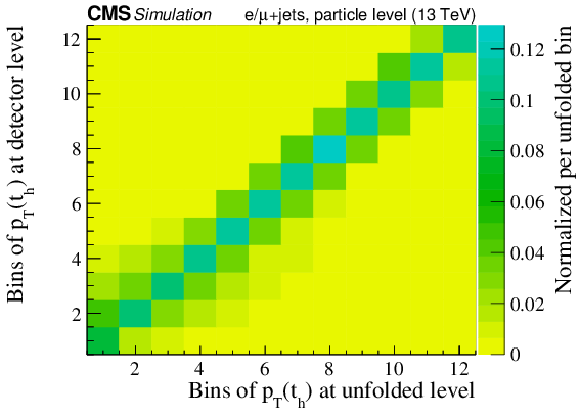
png pdf |
Figure 8-d:
Migration studies of the parton (top) and particle (bottom) level measurements of pT (th), extracted from the POWHEG+PYTHIA8 simulation. Left : purity, stability, and efficiency per bin. Right : bin migrations between detector and parton (particle) level. The pT range of the bins can be taken from the left panels. Each column is normalized to the number of events per column at parton (particle) level in the finally measured phase space. |

png pdf |
Figure 9:
Migration matrices of the particle level measurement of the jet pT spectra, extracted from the POWHEG+PYTHIA8 simulation. Left : purity, stability, and efficiency per bin. Right : bin migrations between detector and particle level. On the axes the pT bins for each jet are shown. Each column is normalized to the number of events per column at particle level. |
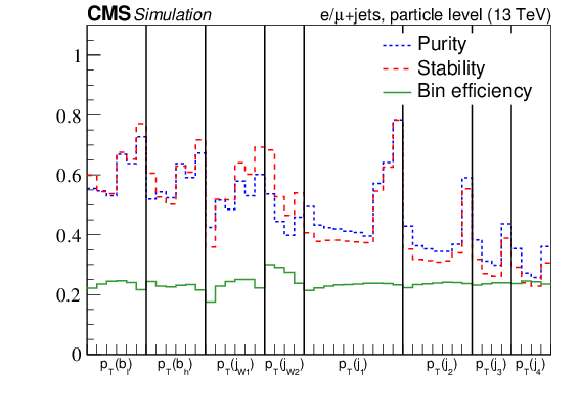
png pdf |
Figure 9-a:
Migration matrices of the particle level measurement of the jet pT spectra, extracted from the POWHEG+PYTHIA8 simulation. Left : purity, stability, and efficiency per bin. Right : bin migrations between detector and particle level. On the axes the pT bins for each jet are shown. Each column is normalized to the number of events per column at particle level. |

png pdf |
Figure 9-b:
Migration matrices of the particle level measurement of the jet pT spectra, extracted from the POWHEG+PYTHIA8 simulation. Left : purity, stability, and efficiency per bin. Right : bin migrations between detector and particle level. On the axes the pT bins for each jet are shown. Each column is normalized to the number of events per column at particle level. |

png pdf |
Figure 10:
Relative uncertainties due to the individual sources in the measurement of pT (th) at parton level (left) and particle level (right). Sources of a maximum uncertainty below 0.5% are summarized in the category "Others''. The combination of the individual sources of jet energy uncertainty is labeled "Jet energy''. The combined uncertainty considers all systematic uncertainties. |

png pdf |
Figure 10-a:
Relative uncertainties due to the individual sources in the measurement of pT (th) at parton level (left) and particle level (right). Sources of a maximum uncertainty below 0.5% are summarized in the category "Others''. The combination of the individual sources of jet energy uncertainty is labeled "Jet energy''. The combined uncertainty considers all systematic uncertainties. |

png pdf |
Figure 10-b:
Relative uncertainties due to the individual sources in the measurement of pT (th) at parton level (left) and particle level (right). Sources of a maximum uncertainty below 0.5% are summarized in the category "Others''. The combination of the individual sources of jet energy uncertainty is labeled "Jet energy''. The combined uncertainty considers all systematic uncertainties. |
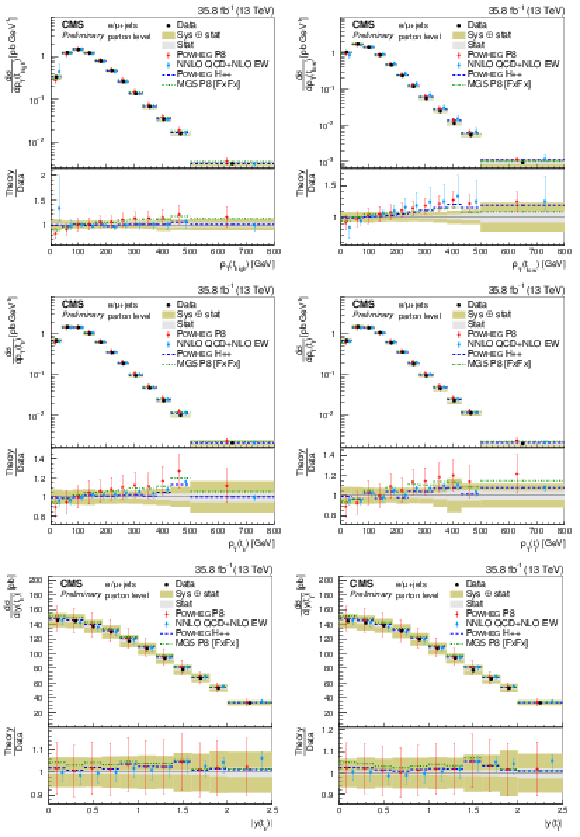
png pdf |
Figure 11:
Differential cross sections at parton level as a function of the top quark with the higher and lower pT (top), pT (th) and pT (tℓ) (middle), and <y(th)> and <y(tℓ)> (bottom). The data are shown as points with light (dark) error bands indicating the statistical (statistical and systematic) uncertainties. The cross sections are compared to the predictions of POWHEG combined with PYTHIA8 (P8) or HERWIG++ (H++), the multiparton simulation MG5_aMC@NLO (MG5)+PYTHIA8 FxFx, and the NNLO QCD+NLO EW calculations. The ratios of the various predictions to the measured cross sections are shown at the bottom of each panel. |

png pdf |
Figure 11-a:
Differential cross sections at parton level as a function of the top quark with the higher and lower pT (top), pT (th) and pT (tℓ) (middle), and <y(th)> and <y(tℓ)> (bottom). The data are shown as points with light (dark) error bands indicating the statistical (statistical and systematic) uncertainties. The cross sections are compared to the predictions of POWHEG combined with PYTHIA8 (P8) or HERWIG++ (H++), the multiparton simulation MG5_aMC@NLO (MG5)+PYTHIA8 FxFx, and the NNLO QCD+NLO EW calculations. The ratios of the various predictions to the measured cross sections are shown at the bottom of each panel. |

png pdf |
Figure 11-b:
Differential cross sections at parton level as a function of the top quark with the higher and lower pT (top), pT (th) and pT (tℓ) (middle), and <y(th)> and <y(tℓ)> (bottom). The data are shown as points with light (dark) error bands indicating the statistical (statistical and systematic) uncertainties. The cross sections are compared to the predictions of POWHEG combined with PYTHIA8 (P8) or HERWIG++ (H++), the multiparton simulation MG5_aMC@NLO (MG5)+PYTHIA8 FxFx, and the NNLO QCD+NLO EW calculations. The ratios of the various predictions to the measured cross sections are shown at the bottom of each panel. |
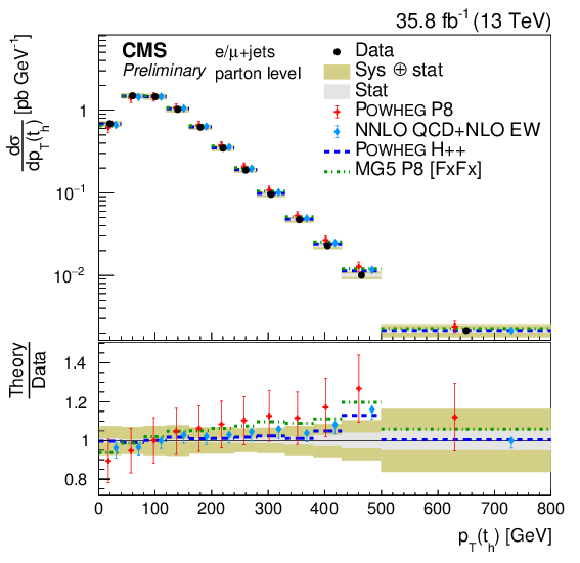
png pdf |
Figure 11-c:
Differential cross sections at parton level as a function of the top quark with the higher and lower pT (top), pT (th) and pT (tℓ) (middle), and <y(th)> and <y(tℓ)> (bottom). The data are shown as points with light (dark) error bands indicating the statistical (statistical and systematic) uncertainties. The cross sections are compared to the predictions of POWHEG combined with PYTHIA8 (P8) or HERWIG++ (H++), the multiparton simulation MG5_aMC@NLO (MG5)+PYTHIA8 FxFx, and the NNLO QCD+NLO EW calculations. The ratios of the various predictions to the measured cross sections are shown at the bottom of each panel. |

png pdf |
Figure 11-d:
Differential cross sections at parton level as a function of the top quark with the higher and lower pT (top), pT (th) and pT (tℓ) (middle), and <y(th)> and <y(tℓ)> (bottom). The data are shown as points with light (dark) error bands indicating the statistical (statistical and systematic) uncertainties. The cross sections are compared to the predictions of POWHEG combined with PYTHIA8 (P8) or HERWIG++ (H++), the multiparton simulation MG5_aMC@NLO (MG5)+PYTHIA8 FxFx, and the NNLO QCD+NLO EW calculations. The ratios of the various predictions to the measured cross sections are shown at the bottom of each panel. |

png pdf |
Figure 11-e:
Differential cross sections at parton level as a function of the top quark with the higher and lower pT (top), pT (th) and pT (tℓ) (middle), and <y(th)> and <y(tℓ)> (bottom). The data are shown as points with light (dark) error bands indicating the statistical (statistical and systematic) uncertainties. The cross sections are compared to the predictions of POWHEG combined with PYTHIA8 (P8) or HERWIG++ (H++), the multiparton simulation MG5_aMC@NLO (MG5)+PYTHIA8 FxFx, and the NNLO QCD+NLO EW calculations. The ratios of the various predictions to the measured cross sections are shown at the bottom of each panel. |

png pdf |
Figure 11-f:
Differential cross sections at parton level as a function of the top quark with the higher and lower pT (top), pT (th) and pT (tℓ) (middle), and <y(th)> and <y(tℓ)> (bottom). The data are shown as points with light (dark) error bands indicating the statistical (statistical and systematic) uncertainties. The cross sections are compared to the predictions of POWHEG combined with PYTHIA8 (P8) or HERWIG++ (H++), the multiparton simulation MG5_aMC@NLO (MG5)+PYTHIA8 FxFx, and the NNLO QCD+NLO EW calculations. The ratios of the various predictions to the measured cross sections are shown at the bottom of each panel. |

png pdf |
Figure 12:
Differential cross sections at particle level as a function of pT (t) (top) and <y(t)> (bottom) measured separately for the hadronically (left) and leptonically (right) decaying particle-level top quarks. The data are shown as points with light (dark) error bands indicating the statistical (statistical and systematic) uncertainties. The cross sections are compared to the predictions of POWHEG combined with PYTHIA8 (P8) or HERWIG++ (H++) and the multiparton simulations MG5_aMC@NLO (MG5)+PYTHIA8 FxFx and {sherpa}. The ratios of the various predictions to the measured cross sections are shown at the bottom of each panel. |

png pdf |
Figure 12-a:
Differential cross sections at particle level as a function of pT (t) (top) and <y(t)> (bottom) measured separately for the hadronically (left) and leptonically (right) decaying particle-level top quarks. The data are shown as points with light (dark) error bands indicating the statistical (statistical and systematic) uncertainties. The cross sections are compared to the predictions of POWHEG combined with PYTHIA8 (P8) or HERWIG++ (H++) and the multiparton simulations MG5_aMC@NLO (MG5)+PYTHIA8 FxFx and {sherpa}. The ratios of the various predictions to the measured cross sections are shown at the bottom of each panel. |
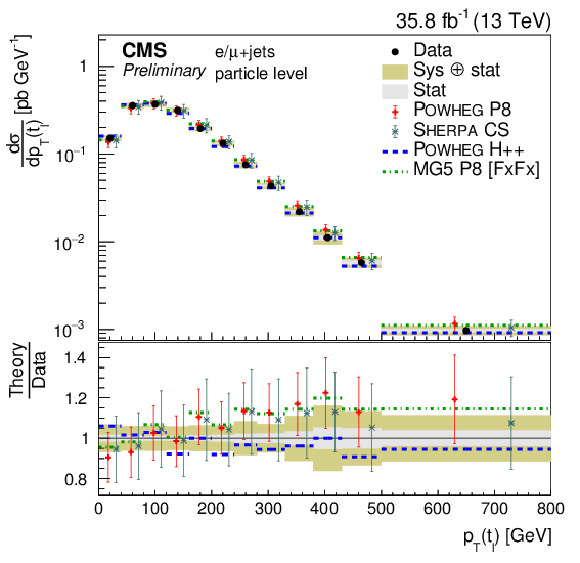
png pdf |
Figure 12-b:
Differential cross sections at particle level as a function of pT (t) (top) and <y(t)> (bottom) measured separately for the hadronically (left) and leptonically (right) decaying particle-level top quarks. The data are shown as points with light (dark) error bands indicating the statistical (statistical and systematic) uncertainties. The cross sections are compared to the predictions of POWHEG combined with PYTHIA8 (P8) or HERWIG++ (H++) and the multiparton simulations MG5_aMC@NLO (MG5)+PYTHIA8 FxFx and {sherpa}. The ratios of the various predictions to the measured cross sections are shown at the bottom of each panel. |

png pdf |
Figure 12-c:
Differential cross sections at particle level as a function of pT (t) (top) and <y(t)> (bottom) measured separately for the hadronically (left) and leptonically (right) decaying particle-level top quarks. The data are shown as points with light (dark) error bands indicating the statistical (statistical and systematic) uncertainties. The cross sections are compared to the predictions of POWHEG combined with PYTHIA8 (P8) or HERWIG++ (H++) and the multiparton simulations MG5_aMC@NLO (MG5)+PYTHIA8 FxFx and {sherpa}. The ratios of the various predictions to the measured cross sections are shown at the bottom of each panel. |
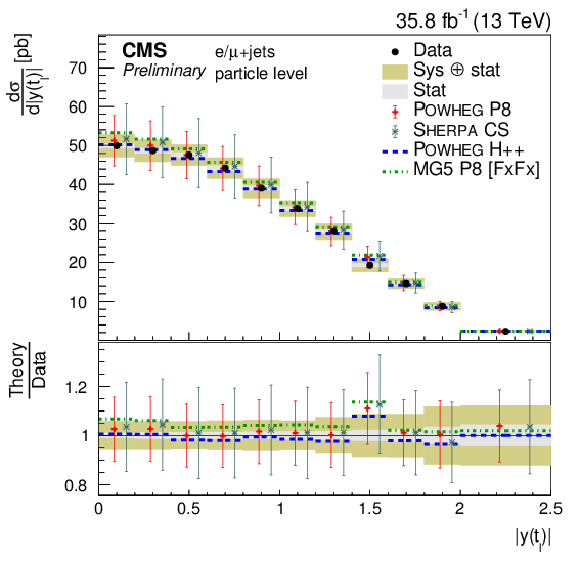
png pdf |
Figure 12-d:
Differential cross sections at particle level as a function of pT (t) (top) and <y(t)> (bottom) measured separately for the hadronically (left) and leptonically (right) decaying particle-level top quarks. The data are shown as points with light (dark) error bands indicating the statistical (statistical and systematic) uncertainties. The cross sections are compared to the predictions of POWHEG combined with PYTHIA8 (P8) or HERWIG++ (H++) and the multiparton simulations MG5_aMC@NLO (MG5)+PYTHIA8 FxFx and {sherpa}. The ratios of the various predictions to the measured cross sections are shown at the bottom of each panel. |

png pdf |
Figure 13:
Differential cross sections at parton level as a function of pT (tˉt), <y(tˉt)>, and M(tˉt). The data are shown as points with light (dark) error bands indicating the statistical (statistical and systematic) uncertainties. The cross sections are compared to the predictions of POWHEG combined with PYTHIA8 (P8) or HERWIG++ (H++), the multiparton simulations MG5_aMC@NLO (MG5)+PYTHIA8 FxFx, and the NNLO QCD+NLO EW calculations. The ratios of the various predictions to the measured cross sections are shown at the bottom of each panel. |

png pdf |
Figure 13-a:
Differential cross sections at parton level as a function of pT (tˉt), <y(tˉt)>, and M(tˉt). The data are shown as points with light (dark) error bands indicating the statistical (statistical and systematic) uncertainties. The cross sections are compared to the predictions of POWHEG combined with PYTHIA8 (P8) or HERWIG++ (H++), the multiparton simulations MG5_aMC@NLO (MG5)+PYTHIA8 FxFx, and the NNLO QCD+NLO EW calculations. The ratios of the various predictions to the measured cross sections are shown at the bottom of each panel. |

png pdf |
Figure 13-b:
Differential cross sections at parton level as a function of pT (tˉt), <y(tˉt)>, and M(tˉt). The data are shown as points with light (dark) error bands indicating the statistical (statistical and systematic) uncertainties. The cross sections are compared to the predictions of POWHEG combined with PYTHIA8 (P8) or HERWIG++ (H++), the multiparton simulations MG5_aMC@NLO (MG5)+PYTHIA8 FxFx, and the NNLO QCD+NLO EW calculations. The ratios of the various predictions to the measured cross sections are shown at the bottom of each panel. |

png pdf |
Figure 13-c:
Differential cross sections at parton level as a function of pT (tˉt), <y(tˉt)>, and M(tˉt). The data are shown as points with light (dark) error bands indicating the statistical (statistical and systematic) uncertainties. The cross sections are compared to the predictions of POWHEG combined with PYTHIA8 (P8) or HERWIG++ (H++), the multiparton simulations MG5_aMC@NLO (MG5)+PYTHIA8 FxFx, and the NNLO QCD+NLO EW calculations. The ratios of the various predictions to the measured cross sections are shown at the bottom of each panel. |

png pdf |
Figure 14:
Differential cross sections at particle level as a function of pT (tˉt), <y(tˉt)>, and M(tˉt). The data are shown as points with light (dark) error bands indicating the statistical (statistical and systematic) uncertainties. The cross sections are compared to the predictions of POWHEG combined with PYTHIA8 (P8) or HERWIG++ (H++) and the multiparton simulations MG5_aMC@NLO (MG5)+PYTHIA8 FxFx and {sherpa}. The ratios of the various predictions to the measured cross sections are shown at the bottom of each panel. |

png pdf |
Figure 14-a:
Differential cross sections at particle level as a function of pT (tˉt), <y(tˉt)>, and M(tˉt). The data are shown as points with light (dark) error bands indicating the statistical (statistical and systematic) uncertainties. The cross sections are compared to the predictions of POWHEG combined with PYTHIA8 (P8) or HERWIG++ (H++) and the multiparton simulations MG5_aMC@NLO (MG5)+PYTHIA8 FxFx and {sherpa}. The ratios of the various predictions to the measured cross sections are shown at the bottom of each panel. |
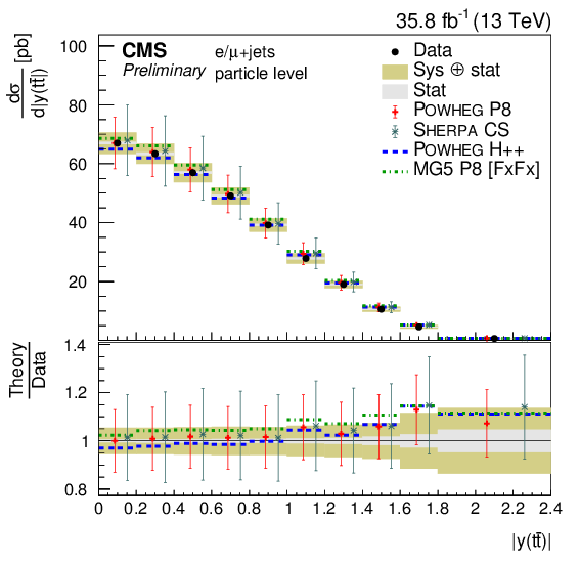
png pdf |
Figure 14-b:
Differential cross sections at particle level as a function of pT (tˉt), <y(tˉt)>, and M(tˉt). The data are shown as points with light (dark) error bands indicating the statistical (statistical and systematic) uncertainties. The cross sections are compared to the predictions of POWHEG combined with PYTHIA8 (P8) or HERWIG++ (H++) and the multiparton simulations MG5_aMC@NLO (MG5)+PYTHIA8 FxFx and {sherpa}. The ratios of the various predictions to the measured cross sections are shown at the bottom of each panel. |

png pdf |
Figure 14-c:
Differential cross sections at particle level as a function of pT (tˉt), <y(tˉt)>, and M(tˉt). The data are shown as points with light (dark) error bands indicating the statistical (statistical and systematic) uncertainties. The cross sections are compared to the predictions of POWHEG combined with PYTHIA8 (P8) or HERWIG++ (H++) and the multiparton simulations MG5_aMC@NLO (MG5)+PYTHIA8 FxFx and {sherpa}. The ratios of the various predictions to the measured cross sections are shown at the bottom of each panel. |
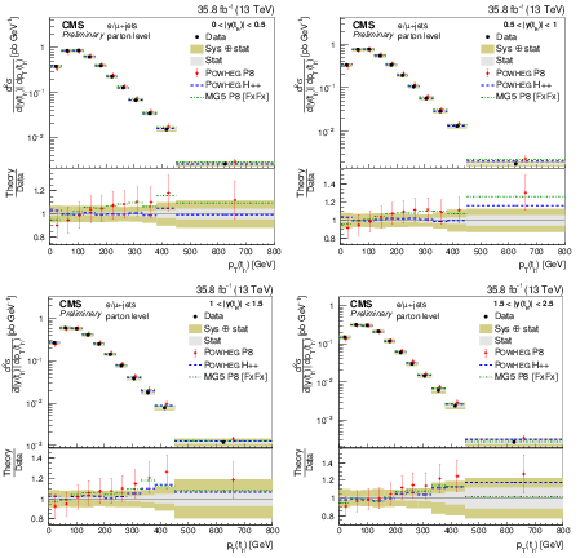
png pdf |
Figure 15:
Double-differential cross section at parton level as a function of <y(th)> v.s. pT (th). The data are shown as points with light (dark) error bands indicating the statistical (statistical and systematic) uncertainties. The cross sections are compared to the predictions of POWHEG combined with PYTHIA8 (P8) or HERWIG++ (H++) and the multiparton simulation MG5_aMC@NLO (MG5)+PYTHIA8 FxFx. The ratios of the predictions to the measured cross sections are shown at the bottom of each panel. |

png pdf |
Figure 15-a:
Double-differential cross section at parton level as a function of <y(th)> v.s. pT (th). The data are shown as points with light (dark) error bands indicating the statistical (statistical and systematic) uncertainties. The cross sections are compared to the predictions of POWHEG combined with PYTHIA8 (P8) or HERWIG++ (H++) and the multiparton simulation MG5_aMC@NLO (MG5)+PYTHIA8 FxFx. The ratios of the predictions to the measured cross sections are shown at the bottom of each panel. |

png pdf |
Figure 15-b:
Double-differential cross section at parton level as a function of <y(th)> v.s. pT (th). The data are shown as points with light (dark) error bands indicating the statistical (statistical and systematic) uncertainties. The cross sections are compared to the predictions of POWHEG combined with PYTHIA8 (P8) or HERWIG++ (H++) and the multiparton simulation MG5_aMC@NLO (MG5)+PYTHIA8 FxFx. The ratios of the predictions to the measured cross sections are shown at the bottom of each panel. |

png pdf |
Figure 15-c:
Double-differential cross section at parton level as a function of <y(th)> v.s. pT (th). The data are shown as points with light (dark) error bands indicating the statistical (statistical and systematic) uncertainties. The cross sections are compared to the predictions of POWHEG combined with PYTHIA8 (P8) or HERWIG++ (H++) and the multiparton simulation MG5_aMC@NLO (MG5)+PYTHIA8 FxFx. The ratios of the predictions to the measured cross sections are shown at the bottom of each panel. |
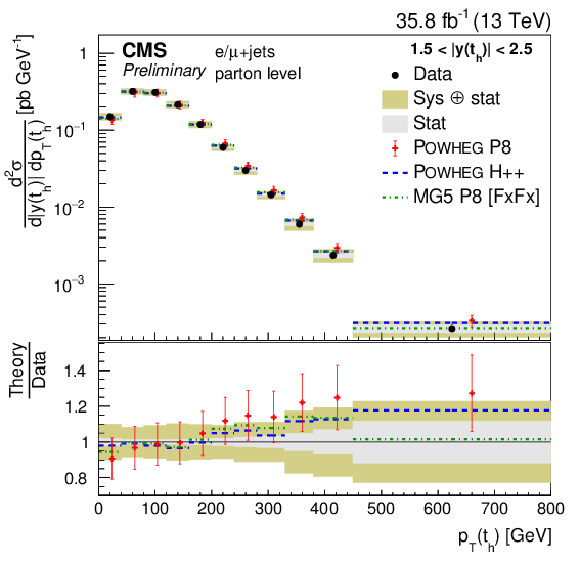
png pdf |
Figure 15-d:
Double-differential cross section at parton level as a function of <y(th)> v.s. pT (th). The data are shown as points with light (dark) error bands indicating the statistical (statistical and systematic) uncertainties. The cross sections are compared to the predictions of POWHEG combined with PYTHIA8 (P8) or HERWIG++ (H++) and the multiparton simulation MG5_aMC@NLO (MG5)+PYTHIA8 FxFx. The ratios of the predictions to the measured cross sections are shown at the bottom of each panel. |

png pdf |
Figure 16:
Double-differential cross section at particle level as a function of <y(th)> v.s. pT (th). The data are shown as points with light (dark) error bands indicating the statistical (statistical and systematic) uncertainties. The cross sections are compared to the predictions of POWHEG combined with PYTHIA8 (P8) or HERWIG++ (H++) and the multiparton simulations MG5_aMC@NLO (MG5)+PYTHIA8 FxFx and {sherpa}. The ratios of the predictions to the measured cross sections are shown at the bottom of each panel. |

png pdf |
Figure 16-a:
Double-differential cross section at particle level as a function of <y(th)> v.s. pT (th). The data are shown as points with light (dark) error bands indicating the statistical (statistical and systematic) uncertainties. The cross sections are compared to the predictions of POWHEG combined with PYTHIA8 (P8) or HERWIG++ (H++) and the multiparton simulations MG5_aMC@NLO (MG5)+PYTHIA8 FxFx and {sherpa}. The ratios of the predictions to the measured cross sections are shown at the bottom of each panel. |
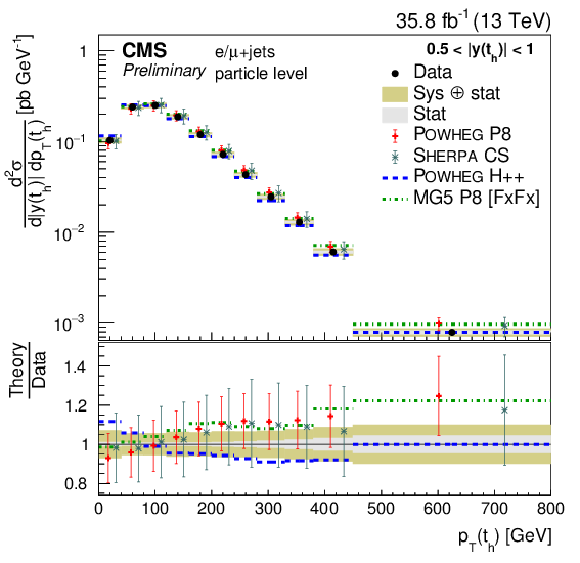
png pdf |
Figure 16-b:
Double-differential cross section at particle level as a function of <y(th)> v.s. pT (th). The data are shown as points with light (dark) error bands indicating the statistical (statistical and systematic) uncertainties. The cross sections are compared to the predictions of POWHEG combined with PYTHIA8 (P8) or HERWIG++ (H++) and the multiparton simulations MG5_aMC@NLO (MG5)+PYTHIA8 FxFx and {sherpa}. The ratios of the predictions to the measured cross sections are shown at the bottom of each panel. |

png pdf |
Figure 16-c:
Double-differential cross section at particle level as a function of <y(th)> v.s. pT (th). The data are shown as points with light (dark) error bands indicating the statistical (statistical and systematic) uncertainties. The cross sections are compared to the predictions of POWHEG combined with PYTHIA8 (P8) or HERWIG++ (H++) and the multiparton simulations MG5_aMC@NLO (MG5)+PYTHIA8 FxFx and {sherpa}. The ratios of the predictions to the measured cross sections are shown at the bottom of each panel. |

png pdf |
Figure 16-d:
Double-differential cross section at particle level as a function of <y(th)> v.s. pT (th). The data are shown as points with light (dark) error bands indicating the statistical (statistical and systematic) uncertainties. The cross sections are compared to the predictions of POWHEG combined with PYTHIA8 (P8) or HERWIG++ (H++) and the multiparton simulations MG5_aMC@NLO (MG5)+PYTHIA8 FxFx and {sherpa}. The ratios of the predictions to the measured cross sections are shown at the bottom of each panel. |
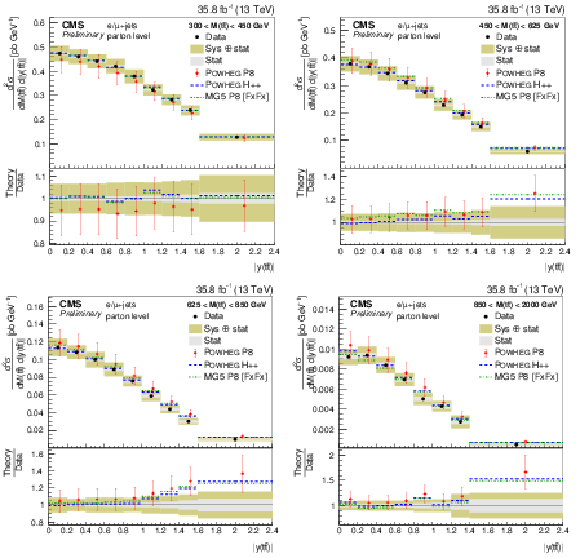
png pdf |
Figure 17:
Double-differential cross section at parton level as a function of M(tˉt) v.s. <y(tˉt)>. The data are shown as points with light (dark) error bands indicating the statistical (statistical and systematic) uncertainties. The cross sections are compared to the predictions of POWHEG combined with PYTHIA8 (P8) or HERWIG++ (H++) and the multiparton simulation MG5_aMC@NLO (MG5)+PYTHIA8 FxFx. The ratios of the predictions to the measured cross sections are shown at the bottom of each panel. |

png pdf |
Figure 17-a:
Double-differential cross section at parton level as a function of M(tˉt) v.s. <y(tˉt)>. The data are shown as points with light (dark) error bands indicating the statistical (statistical and systematic) uncertainties. The cross sections are compared to the predictions of POWHEG combined with PYTHIA8 (P8) or HERWIG++ (H++) and the multiparton simulation MG5_aMC@NLO (MG5)+PYTHIA8 FxFx. The ratios of the predictions to the measured cross sections are shown at the bottom of each panel. |

png pdf |
Figure 17-b:
Double-differential cross section at parton level as a function of M(tˉt) v.s. <y(tˉt)>. The data are shown as points with light (dark) error bands indicating the statistical (statistical and systematic) uncertainties. The cross sections are compared to the predictions of POWHEG combined with PYTHIA8 (P8) or HERWIG++ (H++) and the multiparton simulation MG5_aMC@NLO (MG5)+PYTHIA8 FxFx. The ratios of the predictions to the measured cross sections are shown at the bottom of each panel. |

png pdf |
Figure 17-c:
Double-differential cross section at parton level as a function of M(tˉt) v.s. <y(tˉt)>. The data are shown as points with light (dark) error bands indicating the statistical (statistical and systematic) uncertainties. The cross sections are compared to the predictions of POWHEG combined with PYTHIA8 (P8) or HERWIG++ (H++) and the multiparton simulation MG5_aMC@NLO (MG5)+PYTHIA8 FxFx. The ratios of the predictions to the measured cross sections are shown at the bottom of each panel. |

png pdf |
Figure 17-d:
Double-differential cross section at parton level as a function of M(tˉt) v.s. <y(tˉt)>. The data are shown as points with light (dark) error bands indicating the statistical (statistical and systematic) uncertainties. The cross sections are compared to the predictions of POWHEG combined with PYTHIA8 (P8) or HERWIG++ (H++) and the multiparton simulation MG5_aMC@NLO (MG5)+PYTHIA8 FxFx. The ratios of the predictions to the measured cross sections are shown at the bottom of each panel. |

png pdf |
Figure 18:
Double-differential cross section at particle level as a function of M(tˉt) v.s. <y(tˉt)>. The data are shown as points with light (dark) error bands indicating the statistical (statistical and systematic) uncertainties. The cross sections are compared to the predictions of POWHEG combined with PYTHIA8 (P8) or HERWIG++ (H++) and the multiparton simulations MG5_aMC@NLO (MG5)+PYTHIA8 FxFx and {sherpa}. The ratios of the predictions to the measured cross sections are shown at the bottom of each panel. |
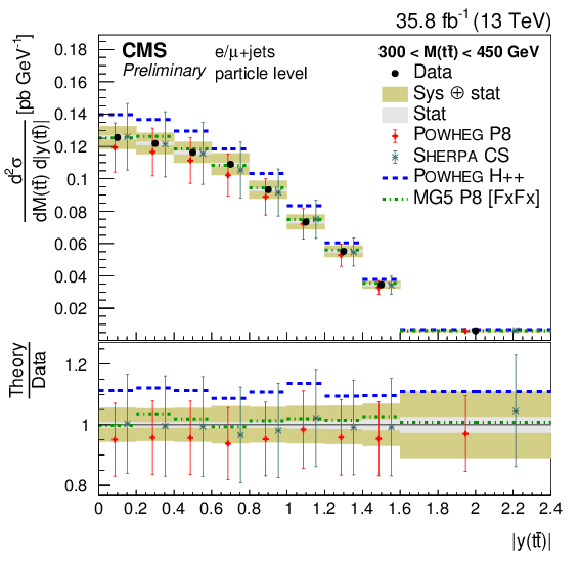
png pdf |
Figure 18-a:
Double-differential cross section at particle level as a function of M(tˉt) v.s. <y(tˉt)>. The data are shown as points with light (dark) error bands indicating the statistical (statistical and systematic) uncertainties. The cross sections are compared to the predictions of POWHEG combined with PYTHIA8 (P8) or HERWIG++ (H++) and the multiparton simulations MG5_aMC@NLO (MG5)+PYTHIA8 FxFx and {sherpa}. The ratios of the predictions to the measured cross sections are shown at the bottom of each panel. |

png pdf |
Figure 18-b:
Double-differential cross section at particle level as a function of M(tˉt) v.s. <y(tˉt)>. The data are shown as points with light (dark) error bands indicating the statistical (statistical and systematic) uncertainties. The cross sections are compared to the predictions of POWHEG combined with PYTHIA8 (P8) or HERWIG++ (H++) and the multiparton simulations MG5_aMC@NLO (MG5)+PYTHIA8 FxFx and {sherpa}. The ratios of the predictions to the measured cross sections are shown at the bottom of each panel. |

png pdf |
Figure 18-c:
Double-differential cross section at particle level as a function of M(tˉt) v.s. <y(tˉt)>. The data are shown as points with light (dark) error bands indicating the statistical (statistical and systematic) uncertainties. The cross sections are compared to the predictions of POWHEG combined with PYTHIA8 (P8) or HERWIG++ (H++) and the multiparton simulations MG5_aMC@NLO (MG5)+PYTHIA8 FxFx and {sherpa}. The ratios of the predictions to the measured cross sections are shown at the bottom of each panel. |

png pdf |
Figure 18-d:
Double-differential cross section at particle level as a function of M(tˉt) v.s. <y(tˉt)>. The data are shown as points with light (dark) error bands indicating the statistical (statistical and systematic) uncertainties. The cross sections are compared to the predictions of POWHEG combined with PYTHIA8 (P8) or HERWIG++ (H++) and the multiparton simulations MG5_aMC@NLO (MG5)+PYTHIA8 FxFx and {sherpa}. The ratios of the predictions to the measured cross sections are shown at the bottom of each panel. |
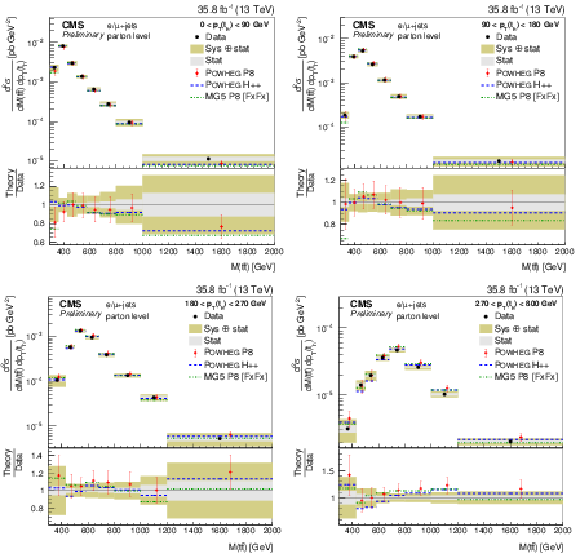
png pdf |
Figure 19:
Double-differential cross section at parton level as a function of pT (th) v.s. M(tˉt). The data are shown as points with light (dark) error bands indicating the statistical (statistical and systematic) uncertainties. The cross sections are compared to the predictions of POWHEG combined with PYTHIA8 (P8) or HERWIG++ (H++) and the multiparton simulation MG5_aMC@NLO (MG5)+PYTHIA8 FxFx. The ratios of the predictions to the measured cross sections are shown at the bottom of each panel. |

png pdf |
Figure 19-a:
Double-differential cross section at parton level as a function of pT (th) v.s. M(tˉt). The data are shown as points with light (dark) error bands indicating the statistical (statistical and systematic) uncertainties. The cross sections are compared to the predictions of POWHEG combined with PYTHIA8 (P8) or HERWIG++ (H++) and the multiparton simulation MG5_aMC@NLO (MG5)+PYTHIA8 FxFx. The ratios of the predictions to the measured cross sections are shown at the bottom of each panel. |

png pdf |
Figure 19-b:
Double-differential cross section at parton level as a function of pT (th) v.s. M(tˉt). The data are shown as points with light (dark) error bands indicating the statistical (statistical and systematic) uncertainties. The cross sections are compared to the predictions of POWHEG combined with PYTHIA8 (P8) or HERWIG++ (H++) and the multiparton simulation MG5_aMC@NLO (MG5)+PYTHIA8 FxFx. The ratios of the predictions to the measured cross sections are shown at the bottom of each panel. |

png pdf |
Figure 19-c:
Double-differential cross section at parton level as a function of pT (th) v.s. M(tˉt). The data are shown as points with light (dark) error bands indicating the statistical (statistical and systematic) uncertainties. The cross sections are compared to the predictions of POWHEG combined with PYTHIA8 (P8) or HERWIG++ (H++) and the multiparton simulation MG5_aMC@NLO (MG5)+PYTHIA8 FxFx. The ratios of the predictions to the measured cross sections are shown at the bottom of each panel. |

png pdf |
Figure 19-d:
Double-differential cross section at parton level as a function of pT (th) v.s. M(tˉt). The data are shown as points with light (dark) error bands indicating the statistical (statistical and systematic) uncertainties. The cross sections are compared to the predictions of POWHEG combined with PYTHIA8 (P8) or HERWIG++ (H++) and the multiparton simulation MG5_aMC@NLO (MG5)+PYTHIA8 FxFx. The ratios of the predictions to the measured cross sections are shown at the bottom of each panel. |
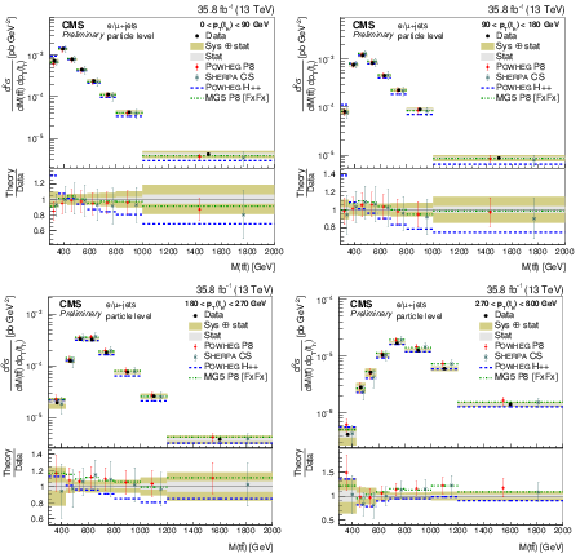
png pdf |
Figure 20:
Double-differential cross section at particle level as a function of <y(tˉt)> v.s. M(tˉt). The data are shown as points with light (dark) error bands indicating the statistical (statistical and systematic) uncertainties. The cross sections are compared to the predictions of POWHEG combined with PYTHIA8 (P8) or HERWIG++ (H++) and the multiparton simulations MG5_aMC@NLO (MG5)+PYTHIA8 FxFx and {sherpa}. The ratios of the predictions to the measured cross sections are shown at the bottom of each panel. |

png pdf |
Figure 20-a:
Double-differential cross section at particle level as a function of <y(tˉt)> v.s. M(tˉt). The data are shown as points with light (dark) error bands indicating the statistical (statistical and systematic) uncertainties. The cross sections are compared to the predictions of POWHEG combined with PYTHIA8 (P8) or HERWIG++ (H++) and the multiparton simulations MG5_aMC@NLO (MG5)+PYTHIA8 FxFx and {sherpa}. The ratios of the predictions to the measured cross sections are shown at the bottom of each panel. |

png pdf |
Figure 20-b:
Double-differential cross section at particle level as a function of <y(tˉt)> v.s. M(tˉt). The data are shown as points with light (dark) error bands indicating the statistical (statistical and systematic) uncertainties. The cross sections are compared to the predictions of POWHEG combined with PYTHIA8 (P8) or HERWIG++ (H++) and the multiparton simulations MG5_aMC@NLO (MG5)+PYTHIA8 FxFx and {sherpa}. The ratios of the predictions to the measured cross sections are shown at the bottom of each panel. |

png pdf |
Figure 20-c:
Double-differential cross section at particle level as a function of <y(tˉt)> v.s. M(tˉt). The data are shown as points with light (dark) error bands indicating the statistical (statistical and systematic) uncertainties. The cross sections are compared to the predictions of POWHEG combined with PYTHIA8 (P8) or HERWIG++ (H++) and the multiparton simulations MG5_aMC@NLO (MG5)+PYTHIA8 FxFx and {sherpa}. The ratios of the predictions to the measured cross sections are shown at the bottom of each panel. |
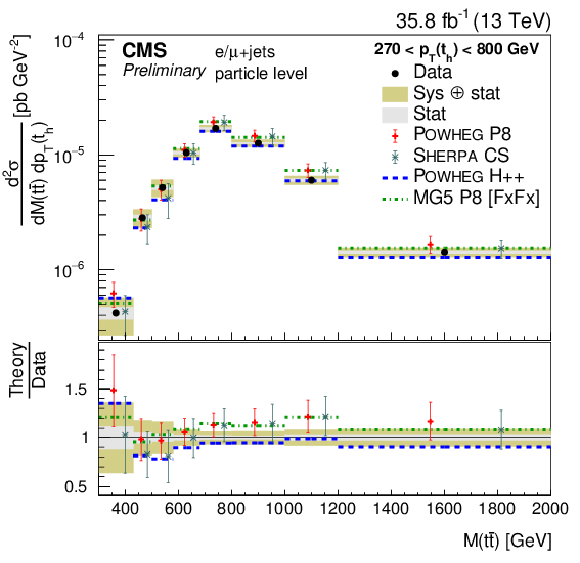
png pdf |
Figure 20-d:
Double-differential cross section at particle level as a function of <y(tˉt)> v.s. M(tˉt). The data are shown as points with light (dark) error bands indicating the statistical (statistical and systematic) uncertainties. The cross sections are compared to the predictions of POWHEG combined with PYTHIA8 (P8) or HERWIG++ (H++) and the multiparton simulations MG5_aMC@NLO (MG5)+PYTHIA8 FxFx and {sherpa}. The ratios of the predictions to the measured cross sections are shown at the bottom of each panel. |

png pdf |
Figure 21:
Differential cross sections at particle level as a function of pT (th) in bins of the number of additional jets. The data are shown as points with light (dark) error bands indicating the statistical (statistical and systematic) uncertainties. The cross sections are compared to the predictions of POWHEG combined with PYTHIA8 (P8) or HERWIG++ (H++) and the multiparton simulations MG5_aMC@NLO (MG5)+PYTHIA8 FxFx and {sherpa}. The ratios of the predictions to the measured cross sections are shown at the bottom of each panel. |
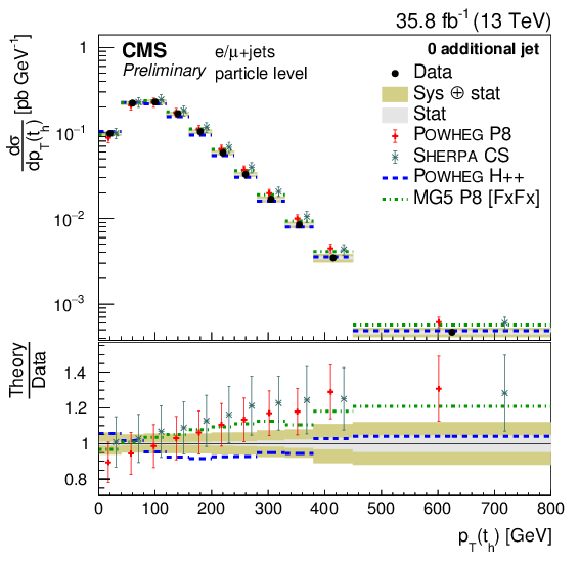
png pdf |
Figure 21-a:
Differential cross sections at particle level as a function of pT (th) in bins of the number of additional jets. The data are shown as points with light (dark) error bands indicating the statistical (statistical and systematic) uncertainties. The cross sections are compared to the predictions of POWHEG combined with PYTHIA8 (P8) or HERWIG++ (H++) and the multiparton simulations MG5_aMC@NLO (MG5)+PYTHIA8 FxFx and {sherpa}. The ratios of the predictions to the measured cross sections are shown at the bottom of each panel. |

png pdf |
Figure 21-b:
Differential cross sections at particle level as a function of pT (th) in bins of the number of additional jets. The data are shown as points with light (dark) error bands indicating the statistical (statistical and systematic) uncertainties. The cross sections are compared to the predictions of POWHEG combined with PYTHIA8 (P8) or HERWIG++ (H++) and the multiparton simulations MG5_aMC@NLO (MG5)+PYTHIA8 FxFx and {sherpa}. The ratios of the predictions to the measured cross sections are shown at the bottom of each panel. |
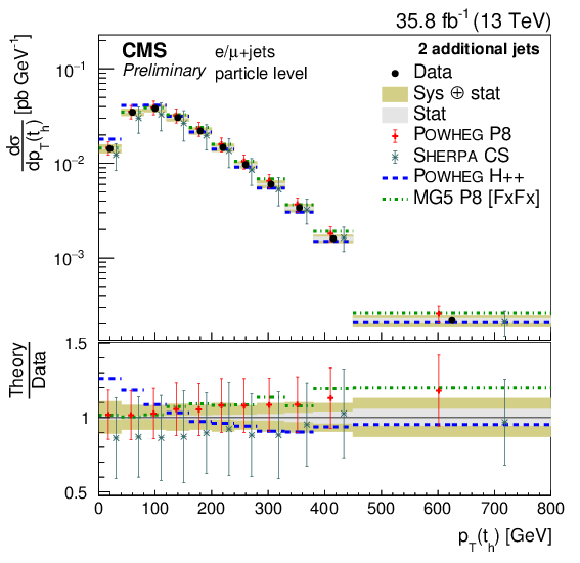
png pdf |
Figure 21-c:
Differential cross sections at particle level as a function of pT (th) in bins of the number of additional jets. The data are shown as points with light (dark) error bands indicating the statistical (statistical and systematic) uncertainties. The cross sections are compared to the predictions of POWHEG combined with PYTHIA8 (P8) or HERWIG++ (H++) and the multiparton simulations MG5_aMC@NLO (MG5)+PYTHIA8 FxFx and {sherpa}. The ratios of the predictions to the measured cross sections are shown at the bottom of each panel. |

png pdf |
Figure 21-d:
Differential cross sections at particle level as a function of pT (th) in bins of the number of additional jets. The data are shown as points with light (dark) error bands indicating the statistical (statistical and systematic) uncertainties. The cross sections are compared to the predictions of POWHEG combined with PYTHIA8 (P8) or HERWIG++ (H++) and the multiparton simulations MG5_aMC@NLO (MG5)+PYTHIA8 FxFx and {sherpa}. The ratios of the predictions to the measured cross sections are shown at the bottom of each panel. |

png pdf |
Figure 22:
Differential cross sections at particle level as a function of M(tˉt) in bins of the number of additional jets. The data are shown as points with light (dark) error bands indicating the statistical (statistical and systematic) uncertainties. The cross sections are compared to the predictions of POWHEG combined with PYTHIA8 (P8) or HERWIG++ (H++) and the multiparton simulations MG5_aMC@NLO (MG5)+PYTHIA8 FxFx and {sherpa}. The ratios of the predictions to the measured cross sections are shown at the bottom of each panel. |

png pdf |
Figure 22-a:
Differential cross sections at particle level as a function of M(tˉt) in bins of the number of additional jets. The data are shown as points with light (dark) error bands indicating the statistical (statistical and systematic) uncertainties. The cross sections are compared to the predictions of POWHEG combined with PYTHIA8 (P8) or HERWIG++ (H++) and the multiparton simulations MG5_aMC@NLO (MG5)+PYTHIA8 FxFx and {sherpa}. The ratios of the predictions to the measured cross sections are shown at the bottom of each panel. |

png pdf |
Figure 22-b:
Differential cross sections at particle level as a function of M(tˉt) in bins of the number of additional jets. The data are shown as points with light (dark) error bands indicating the statistical (statistical and systematic) uncertainties. The cross sections are compared to the predictions of POWHEG combined with PYTHIA8 (P8) or HERWIG++ (H++) and the multiparton simulations MG5_aMC@NLO (MG5)+PYTHIA8 FxFx and {sherpa}. The ratios of the predictions to the measured cross sections are shown at the bottom of each panel. |
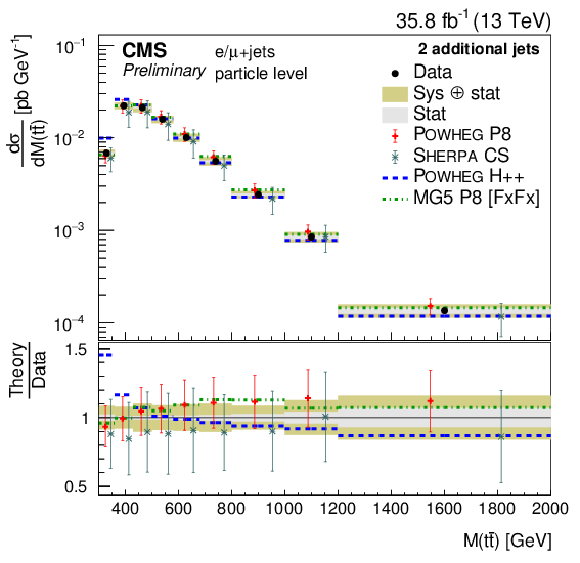
png pdf |
Figure 22-c:
Differential cross sections at particle level as a function of M(tˉt) in bins of the number of additional jets. The data are shown as points with light (dark) error bands indicating the statistical (statistical and systematic) uncertainties. The cross sections are compared to the predictions of POWHEG combined with PYTHIA8 (P8) or HERWIG++ (H++) and the multiparton simulations MG5_aMC@NLO (MG5)+PYTHIA8 FxFx and {sherpa}. The ratios of the predictions to the measured cross sections are shown at the bottom of each panel. |
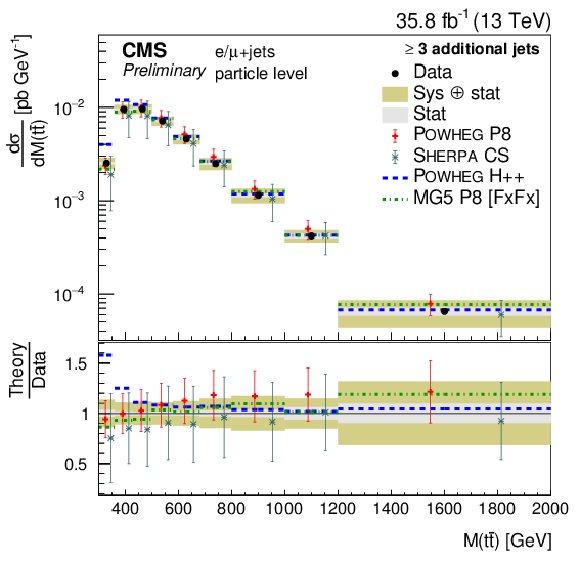
png pdf |
Figure 22-d:
Differential cross sections at particle level as a function of M(tˉt) in bins of the number of additional jets. The data are shown as points with light (dark) error bands indicating the statistical (statistical and systematic) uncertainties. The cross sections are compared to the predictions of POWHEG combined with PYTHIA8 (P8) or HERWIG++ (H++) and the multiparton simulations MG5_aMC@NLO (MG5)+PYTHIA8 FxFx and {sherpa}. The ratios of the predictions to the measured cross sections are shown at the bottom of each panel. |

png pdf |
Figure 23:
Differential cross sections at particle level as a function of pT (tˉt) in bins of the number of additional jets. The data are shown as points with light (dark) error bands indicating the statistical (statistical and systematic) uncertainties. The cross sections are compared to the predictions of POWHEG combined with PYTHIA8 (P8) or HERWIG++ (H++) and the multiparton simulations MG5_aMC@NLO (MG5)+PYTHIA8 FxFx and {sherpa}. The ratios of the predictions to the measured cross sections are shown at the bottom of each panel. |

png pdf |
Figure 23-a:
Differential cross sections at particle level as a function of pT (tˉt) in bins of the number of additional jets. The data are shown as points with light (dark) error bands indicating the statistical (statistical and systematic) uncertainties. The cross sections are compared to the predictions of POWHEG combined with PYTHIA8 (P8) or HERWIG++ (H++) and the multiparton simulations MG5_aMC@NLO (MG5)+PYTHIA8 FxFx and {sherpa}. The ratios of the predictions to the measured cross sections are shown at the bottom of each panel. |
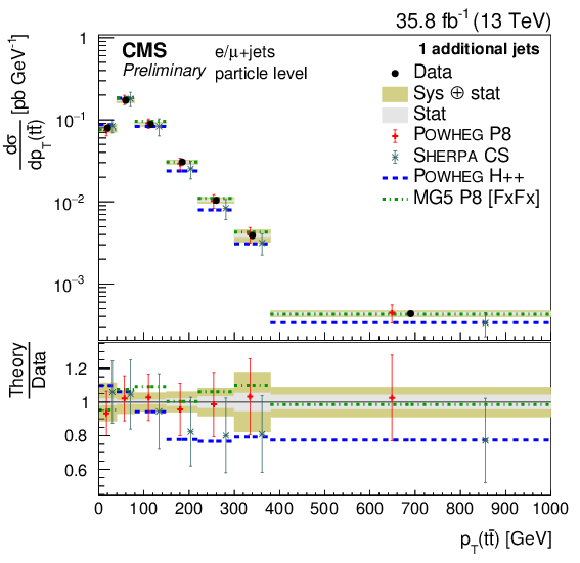
png pdf |
Figure 23-b:
Differential cross sections at particle level as a function of pT (tˉt) in bins of the number of additional jets. The data are shown as points with light (dark) error bands indicating the statistical (statistical and systematic) uncertainties. The cross sections are compared to the predictions of POWHEG combined with PYTHIA8 (P8) or HERWIG++ (H++) and the multiparton simulations MG5_aMC@NLO (MG5)+PYTHIA8 FxFx and {sherpa}. The ratios of the predictions to the measured cross sections are shown at the bottom of each panel. |

png pdf |
Figure 23-c:
Differential cross sections at particle level as a function of pT (tˉt) in bins of the number of additional jets. The data are shown as points with light (dark) error bands indicating the statistical (statistical and systematic) uncertainties. The cross sections are compared to the predictions of POWHEG combined with PYTHIA8 (P8) or HERWIG++ (H++) and the multiparton simulations MG5_aMC@NLO (MG5)+PYTHIA8 FxFx and {sherpa}. The ratios of the predictions to the measured cross sections are shown at the bottom of each panel. |

png pdf |
Figure 23-d:
Differential cross sections at particle level as a function of pT (tˉt) in bins of the number of additional jets. The data are shown as points with light (dark) error bands indicating the statistical (statistical and systematic) uncertainties. The cross sections are compared to the predictions of POWHEG combined with PYTHIA8 (P8) or HERWIG++ (H++) and the multiparton simulations MG5_aMC@NLO (MG5)+PYTHIA8 FxFx and {sherpa}. The ratios of the predictions to the measured cross sections are shown at the bottom of each panel. |

png pdf |
Figure 24:
Differential cross section at particle level as a function of jet pT. The data are shown as points with light (dark) error bands indicating the statistical (statistical and systematic) uncertainties. The cross sections are compared to the predictions of POWHEG combined with PYTHIA8 (P8) or HERWIG++ (H++) and the multiparton simulations MG5_aMC@NLO (MG5)+PYTHIA8 FxFx and {sherpa}. The ratios of the predictions to the measured cross sections are shown at the bottom of each panel. |

png pdf |
Figure 24-a:
Differential cross section at particle level as a function of jet pT. The data are shown as points with light (dark) error bands indicating the statistical (statistical and systematic) uncertainties. The cross sections are compared to the predictions of POWHEG combined with PYTHIA8 (P8) or HERWIG++ (H++) and the multiparton simulations MG5_aMC@NLO (MG5)+PYTHIA8 FxFx and {sherpa}. The ratios of the predictions to the measured cross sections are shown at the bottom of each panel. |

png pdf |
Figure 24-b:
Differential cross section at particle level as a function of jet pT. The data are shown as points with light (dark) error bands indicating the statistical (statistical and systematic) uncertainties. The cross sections are compared to the predictions of POWHEG combined with PYTHIA8 (P8) or HERWIG++ (H++) and the multiparton simulations MG5_aMC@NLO (MG5)+PYTHIA8 FxFx and {sherpa}. The ratios of the predictions to the measured cross sections are shown at the bottom of each panel. |
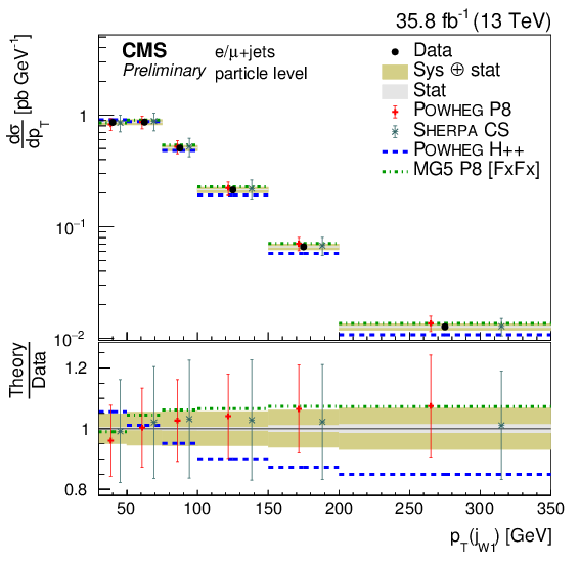
png pdf |
Figure 24-c:
Differential cross section at particle level as a function of jet pT. The data are shown as points with light (dark) error bands indicating the statistical (statistical and systematic) uncertainties. The cross sections are compared to the predictions of POWHEG combined with PYTHIA8 (P8) or HERWIG++ (H++) and the multiparton simulations MG5_aMC@NLO (MG5)+PYTHIA8 FxFx and {sherpa}. The ratios of the predictions to the measured cross sections are shown at the bottom of each panel. |

png pdf |
Figure 24-d:
Differential cross section at particle level as a function of jet pT. The data are shown as points with light (dark) error bands indicating the statistical (statistical and systematic) uncertainties. The cross sections are compared to the predictions of POWHEG combined with PYTHIA8 (P8) or HERWIG++ (H++) and the multiparton simulations MG5_aMC@NLO (MG5)+PYTHIA8 FxFx and {sherpa}. The ratios of the predictions to the measured cross sections are shown at the bottom of each panel. |

png pdf |
Figure 24-e:
Differential cross section at particle level as a function of jet pT. The data are shown as points with light (dark) error bands indicating the statistical (statistical and systematic) uncertainties. The cross sections are compared to the predictions of POWHEG combined with PYTHIA8 (P8) or HERWIG++ (H++) and the multiparton simulations MG5_aMC@NLO (MG5)+PYTHIA8 FxFx and {sherpa}. The ratios of the predictions to the measured cross sections are shown at the bottom of each panel. |
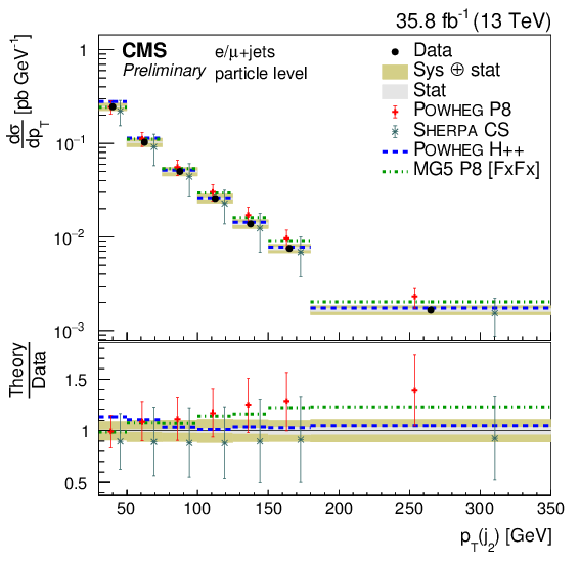
png pdf |
Figure 24-f:
Differential cross section at particle level as a function of jet pT. The data are shown as points with light (dark) error bands indicating the statistical (statistical and systematic) uncertainties. The cross sections are compared to the predictions of POWHEG combined with PYTHIA8 (P8) or HERWIG++ (H++) and the multiparton simulations MG5_aMC@NLO (MG5)+PYTHIA8 FxFx and {sherpa}. The ratios of the predictions to the measured cross sections are shown at the bottom of each panel. |

png pdf |
Figure 24-g:
Differential cross section at particle level as a function of jet pT. The data are shown as points with light (dark) error bands indicating the statistical (statistical and systematic) uncertainties. The cross sections are compared to the predictions of POWHEG combined with PYTHIA8 (P8) or HERWIG++ (H++) and the multiparton simulations MG5_aMC@NLO (MG5)+PYTHIA8 FxFx and {sherpa}. The ratios of the predictions to the measured cross sections are shown at the bottom of each panel. |

png pdf |
Figure 24-h:
Differential cross section at particle level as a function of jet pT. The data are shown as points with light (dark) error bands indicating the statistical (statistical and systematic) uncertainties. The cross sections are compared to the predictions of POWHEG combined with PYTHIA8 (P8) or HERWIG++ (H++) and the multiparton simulations MG5_aMC@NLO (MG5)+PYTHIA8 FxFx and {sherpa}. The ratios of the predictions to the measured cross sections are shown at the bottom of each panel. |

png pdf |
Figure 25:
Top: jet multiplicity. Middle, Bottom: jet multiplicities for various thresholds of the jet pT. The data are shown as points with light (dark) error bands indicating the statistical (statistical and systematic) uncertainties. The cross sections are compared to the predictions of POWHEG combined with PYTHIA8 (P8) or HERWIG++ (H++) and the multiparton simulations MG5_aMC@NLO (MG5)+PYTHIA8 FxFx and {sherpa}. The ratios of the predictions to the measured cross sections are shown at the bottom of each panel. |
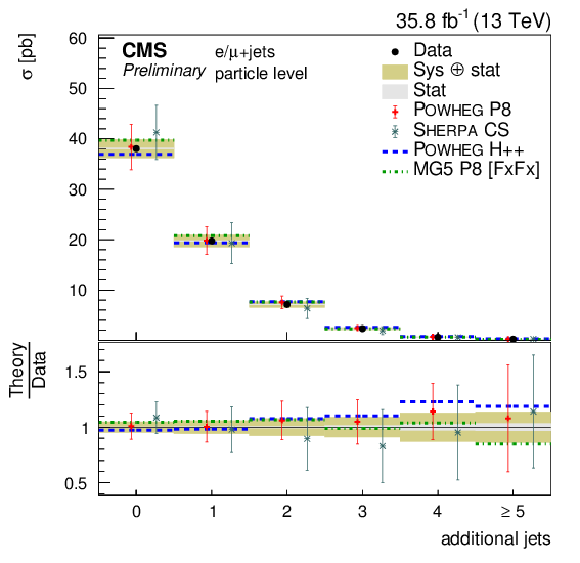
png pdf |
Figure 25-a:
Top: jet multiplicity. Middle, Bottom: jet multiplicities for various thresholds of the jet pT. The data are shown as points with light (dark) error bands indicating the statistical (statistical and systematic) uncertainties. The cross sections are compared to the predictions of POWHEG combined with PYTHIA8 (P8) or HERWIG++ (H++) and the multiparton simulations MG5_aMC@NLO (MG5)+PYTHIA8 FxFx and {sherpa}. The ratios of the predictions to the measured cross sections are shown at the bottom of each panel. |
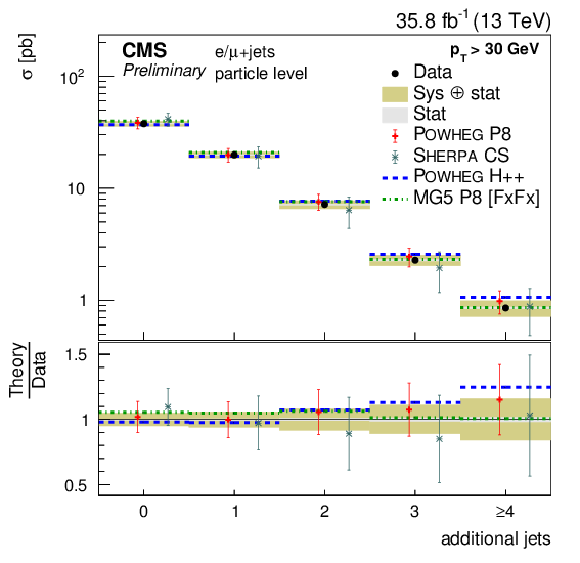
png pdf |
Figure 25-b:
Top: jet multiplicity. Middle, Bottom: jet multiplicities for various thresholds of the jet pT. The data are shown as points with light (dark) error bands indicating the statistical (statistical and systematic) uncertainties. The cross sections are compared to the predictions of POWHEG combined with PYTHIA8 (P8) or HERWIG++ (H++) and the multiparton simulations MG5_aMC@NLO (MG5)+PYTHIA8 FxFx and {sherpa}. The ratios of the predictions to the measured cross sections are shown at the bottom of each panel. |

png pdf |
Figure 25-c:
Top: jet multiplicity. Middle, Bottom: jet multiplicities for various thresholds of the jet pT. The data are shown as points with light (dark) error bands indicating the statistical (statistical and systematic) uncertainties. The cross sections are compared to the predictions of POWHEG combined with PYTHIA8 (P8) or HERWIG++ (H++) and the multiparton simulations MG5_aMC@NLO (MG5)+PYTHIA8 FxFx and {sherpa}. The ratios of the predictions to the measured cross sections are shown at the bottom of each panel. |

png pdf |
Figure 25-d:
Top: jet multiplicity. Middle, Bottom: jet multiplicities for various thresholds of the jet pT. The data are shown as points with light (dark) error bands indicating the statistical (statistical and systematic) uncertainties. The cross sections are compared to the predictions of POWHEG combined with PYTHIA8 (P8) or HERWIG++ (H++) and the multiparton simulations MG5_aMC@NLO (MG5)+PYTHIA8 FxFx and {sherpa}. The ratios of the predictions to the measured cross sections are shown at the bottom of each panel. |

png pdf |
Figure 25-e:
Top: jet multiplicity. Middle, Bottom: jet multiplicities for various thresholds of the jet pT. The data are shown as points with light (dark) error bands indicating the statistical (statistical and systematic) uncertainties. The cross sections are compared to the predictions of POWHEG combined with PYTHIA8 (P8) or HERWIG++ (H++) and the multiparton simulations MG5_aMC@NLO (MG5)+PYTHIA8 FxFx and {sherpa}. The ratios of the predictions to the measured cross sections are shown at the bottom of each panel. |

png pdf |
Figure 26:
Distributions of f1(pT) and f2(pT). The data are shown as points with light (dark) error bands indicating the statistical (statistical and systematic) uncertainties. The measurements are compared to the predictions of POWHEG combined with PYTHIA8 (P8) or HERWIG++ (H++) and the multiparton simulations MG5_aMC@NLO (MG5)+PYTHIA8 FxFx and {sherpa}. The ratios of the predictions to the measured cross sections are shown at the bottom of each panel. |

png pdf |
Figure 26-a:
Distributions of f1(pT) and f2(pT). The data are shown as points with light (dark) error bands indicating the statistical (statistical and systematic) uncertainties. The measurements are compared to the predictions of POWHEG combined with PYTHIA8 (P8) or HERWIG++ (H++) and the multiparton simulations MG5_aMC@NLO (MG5)+PYTHIA8 FxFx and {sherpa}. The ratios of the predictions to the measured cross sections are shown at the bottom of each panel. |

png pdf |
Figure 26-b:
Distributions of f1(pT) and f2(pT). The data are shown as points with light (dark) error bands indicating the statistical (statistical and systematic) uncertainties. The measurements are compared to the predictions of POWHEG combined with PYTHIA8 (P8) or HERWIG++ (H++) and the multiparton simulations MG5_aMC@NLO (MG5)+PYTHIA8 FxFx and {sherpa}. The ratios of the predictions to the measured cross sections are shown at the bottom of each panel. |

png pdf |
Figure 27:
Differential cross section at particle level as a function of jet η. The data are shown as points with light (dark) error bands indicating the statistical (statistical and systematic) uncertainties. The cross sections are compared to the predictions of POWHEG combined with PYTHIA8 (P8) or HERWIG++ (H++) and the multiparton simulations MG5_aMC@NLO (MG5)+PYTHIA8 FxFx and {sherpa}. The ratios of the predictions to the measured cross sections are shown at the bottom of each panel. |

png pdf |
Figure 27-a:
Differential cross section at particle level as a function of jet η. The data are shown as points with light (dark) error bands indicating the statistical (statistical and systematic) uncertainties. The cross sections are compared to the predictions of POWHEG combined with PYTHIA8 (P8) or HERWIG++ (H++) and the multiparton simulations MG5_aMC@NLO (MG5)+PYTHIA8 FxFx and {sherpa}. The ratios of the predictions to the measured cross sections are shown at the bottom of each panel. |

png pdf |
Figure 27-b:
Differential cross section at particle level as a function of jet η. The data are shown as points with light (dark) error bands indicating the statistical (statistical and systematic) uncertainties. The cross sections are compared to the predictions of POWHEG combined with PYTHIA8 (P8) or HERWIG++ (H++) and the multiparton simulations MG5_aMC@NLO (MG5)+PYTHIA8 FxFx and {sherpa}. The ratios of the predictions to the measured cross sections are shown at the bottom of each panel. |

png pdf |
Figure 27-c:
Differential cross section at particle level as a function of jet η. The data are shown as points with light (dark) error bands indicating the statistical (statistical and systematic) uncertainties. The cross sections are compared to the predictions of POWHEG combined with PYTHIA8 (P8) or HERWIG++ (H++) and the multiparton simulations MG5_aMC@NLO (MG5)+PYTHIA8 FxFx and {sherpa}. The ratios of the predictions to the measured cross sections are shown at the bottom of each panel. |

png pdf |
Figure 27-d:
Differential cross section at particle level as a function of jet η. The data are shown as points with light (dark) error bands indicating the statistical (statistical and systematic) uncertainties. The cross sections are compared to the predictions of POWHEG combined with PYTHIA8 (P8) or HERWIG++ (H++) and the multiparton simulations MG5_aMC@NLO (MG5)+PYTHIA8 FxFx and {sherpa}. The ratios of the predictions to the measured cross sections are shown at the bottom of each panel. |

png pdf |
Figure 27-e:
Differential cross section at particle level as a function of jet η. The data are shown as points with light (dark) error bands indicating the statistical (statistical and systematic) uncertainties. The cross sections are compared to the predictions of POWHEG combined with PYTHIA8 (P8) or HERWIG++ (H++) and the multiparton simulations MG5_aMC@NLO (MG5)+PYTHIA8 FxFx and {sherpa}. The ratios of the predictions to the measured cross sections are shown at the bottom of each panel. |

png pdf |
Figure 27-f:
Differential cross section at particle level as a function of jet η. The data are shown as points with light (dark) error bands indicating the statistical (statistical and systematic) uncertainties. The cross sections are compared to the predictions of POWHEG combined with PYTHIA8 (P8) or HERWIG++ (H++) and the multiparton simulations MG5_aMC@NLO (MG5)+PYTHIA8 FxFx and {sherpa}. The ratios of the predictions to the measured cross sections are shown at the bottom of each panel. |

png pdf |
Figure 27-g:
Differential cross section at particle level as a function of jet η. The data are shown as points with light (dark) error bands indicating the statistical (statistical and systematic) uncertainties. The cross sections are compared to the predictions of POWHEG combined with PYTHIA8 (P8) or HERWIG++ (H++) and the multiparton simulations MG5_aMC@NLO (MG5)+PYTHIA8 FxFx and {sherpa}. The ratios of the predictions to the measured cross sections are shown at the bottom of each panel. |
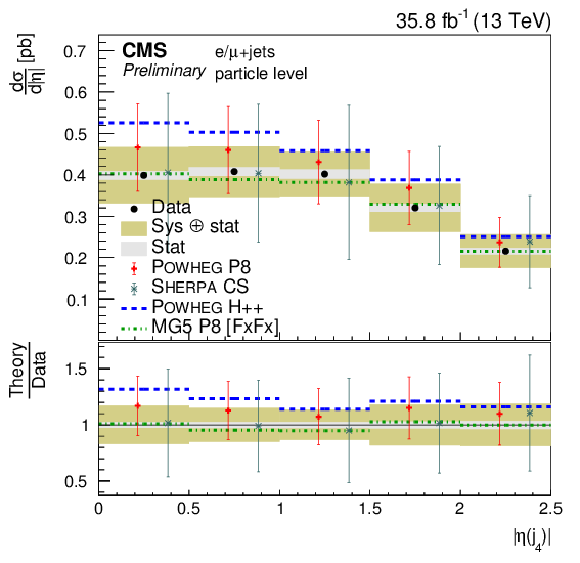
png pdf |
Figure 27-h:
Differential cross section at particle level as a function of jet η. The data are shown as points with light (dark) error bands indicating the statistical (statistical and systematic) uncertainties. The cross sections are compared to the predictions of POWHEG combined with PYTHIA8 (P8) or HERWIG++ (H++) and the multiparton simulations MG5_aMC@NLO (MG5)+PYTHIA8 FxFx and {sherpa}. The ratios of the predictions to the measured cross sections are shown at the bottom of each panel. |

png pdf |
Figure 28:
Differential cross section at particle level as a function of jet ΔRjt. The data are shown as points with light (dark) error bands indicating the statistical (statistical and systematic) uncertainties. The cross sections are compared to the predictions of POWHEG combined with PYTHIA8 (P8) or HERWIG++ (H++) and the multiparton simulations MG5_aMC@NLO (MG5)+PYTHIA8 FxFx and {sherpa}. The ratios of the predictions to the measured cross sections are shown at the bottom of each panel. |
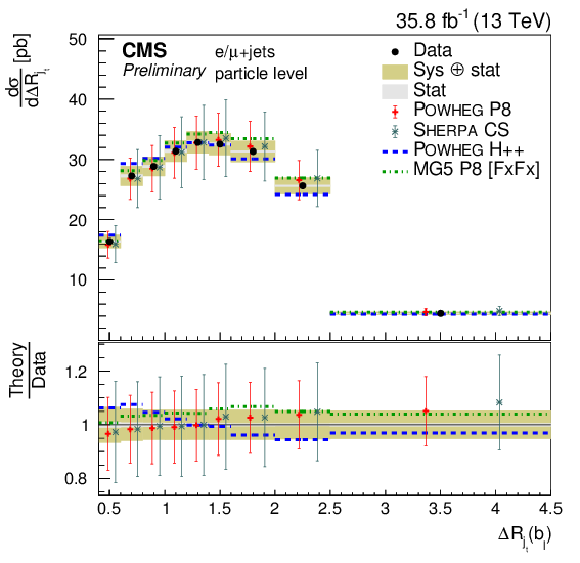
png pdf |
Figure 28-a:
Differential cross section at particle level as a function of jet ΔRjt. The data are shown as points with light (dark) error bands indicating the statistical (statistical and systematic) uncertainties. The cross sections are compared to the predictions of POWHEG combined with PYTHIA8 (P8) or HERWIG++ (H++) and the multiparton simulations MG5_aMC@NLO (MG5)+PYTHIA8 FxFx and {sherpa}. The ratios of the predictions to the measured cross sections are shown at the bottom of each panel. |
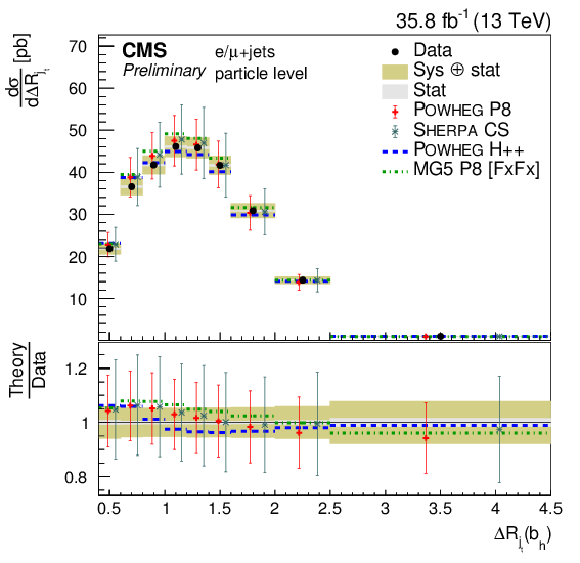
png pdf |
Figure 28-b:
Differential cross section at particle level as a function of jet ΔRjt. The data are shown as points with light (dark) error bands indicating the statistical (statistical and systematic) uncertainties. The cross sections are compared to the predictions of POWHEG combined with PYTHIA8 (P8) or HERWIG++ (H++) and the multiparton simulations MG5_aMC@NLO (MG5)+PYTHIA8 FxFx and {sherpa}. The ratios of the predictions to the measured cross sections are shown at the bottom of each panel. |

png pdf |
Figure 28-c:
Differential cross section at particle level as a function of jet ΔRjt. The data are shown as points with light (dark) error bands indicating the statistical (statistical and systematic) uncertainties. The cross sections are compared to the predictions of POWHEG combined with PYTHIA8 (P8) or HERWIG++ (H++) and the multiparton simulations MG5_aMC@NLO (MG5)+PYTHIA8 FxFx and {sherpa}. The ratios of the predictions to the measured cross sections are shown at the bottom of each panel. |

png pdf |
Figure 28-d:
Differential cross section at particle level as a function of jet ΔRjt. The data are shown as points with light (dark) error bands indicating the statistical (statistical and systematic) uncertainties. The cross sections are compared to the predictions of POWHEG combined with PYTHIA8 (P8) or HERWIG++ (H++) and the multiparton simulations MG5_aMC@NLO (MG5)+PYTHIA8 FxFx and {sherpa}. The ratios of the predictions to the measured cross sections are shown at the bottom of each panel. |

png pdf |
Figure 28-e:
Differential cross section at particle level as a function of jet ΔRjt. The data are shown as points with light (dark) error bands indicating the statistical (statistical and systematic) uncertainties. The cross sections are compared to the predictions of POWHEG combined with PYTHIA8 (P8) or HERWIG++ (H++) and the multiparton simulations MG5_aMC@NLO (MG5)+PYTHIA8 FxFx and {sherpa}. The ratios of the predictions to the measured cross sections are shown at the bottom of each panel. |

png pdf |
Figure 28-f:
Differential cross section at particle level as a function of jet ΔRjt. The data are shown as points with light (dark) error bands indicating the statistical (statistical and systematic) uncertainties. The cross sections are compared to the predictions of POWHEG combined with PYTHIA8 (P8) or HERWIG++ (H++) and the multiparton simulations MG5_aMC@NLO (MG5)+PYTHIA8 FxFx and {sherpa}. The ratios of the predictions to the measured cross sections are shown at the bottom of each panel. |
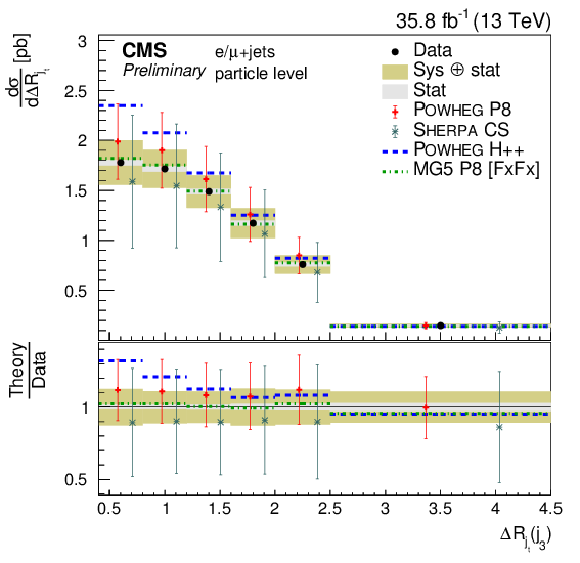
png pdf |
Figure 28-g:
Differential cross section at particle level as a function of jet ΔRjt. The data are shown as points with light (dark) error bands indicating the statistical (statistical and systematic) uncertainties. The cross sections are compared to the predictions of POWHEG combined with PYTHIA8 (P8) or HERWIG++ (H++) and the multiparton simulations MG5_aMC@NLO (MG5)+PYTHIA8 FxFx and {sherpa}. The ratios of the predictions to the measured cross sections are shown at the bottom of each panel. |

png pdf |
Figure 28-h:
Differential cross section at particle level as a function of jet ΔRjt. The data are shown as points with light (dark) error bands indicating the statistical (statistical and systematic) uncertainties. The cross sections are compared to the predictions of POWHEG combined with PYTHIA8 (P8) or HERWIG++ (H++) and the multiparton simulations MG5_aMC@NLO (MG5)+PYTHIA8 FxFx and {sherpa}. The ratios of the predictions to the measured cross sections are shown at the bottom of each panel. |
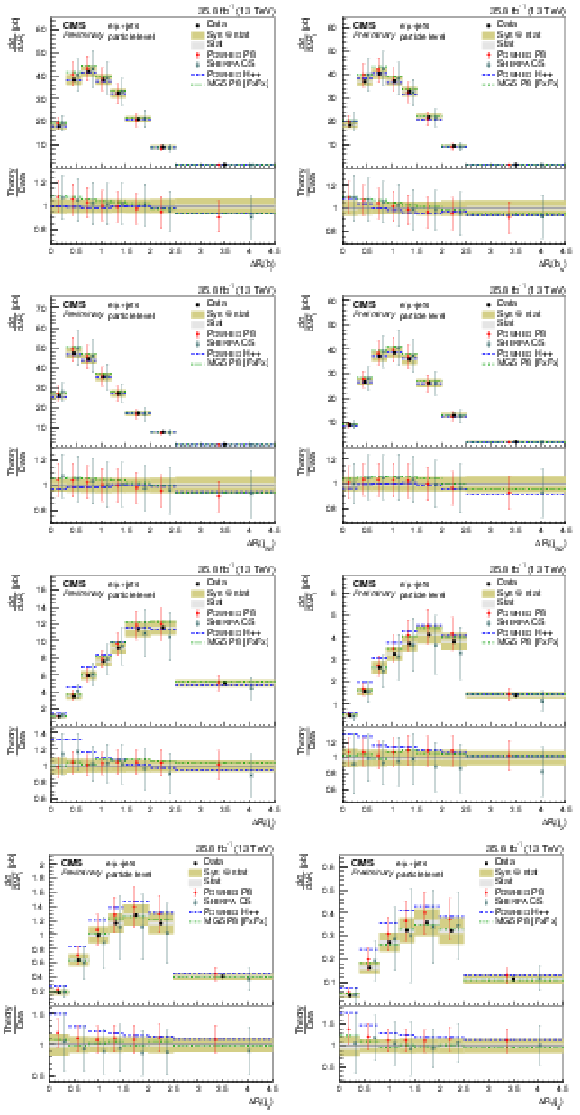
png pdf |
Figure 29:
Differential cross section at particle level as a function of nΔRt. The data are shown as points with light (dark) error bands indicating the statistical (statistical and systematic) uncertainties. The cross sections are compared to the predictions of POWHEG combined with PYTHIA8 (P8) or HERWIG++ (H++) and the multiparton simulations MG5_aMC@NLO (MG5)+PYTHIA8 FxFx and {sherpa}. The ratios of the predictions to the measured cross sections are shown at the bottom of each panel. |

png pdf |
Figure 29-a:
Differential cross section at particle level as a function of nΔRt. The data are shown as points with light (dark) error bands indicating the statistical (statistical and systematic) uncertainties. The cross sections are compared to the predictions of POWHEG combined with PYTHIA8 (P8) or HERWIG++ (H++) and the multiparton simulations MG5_aMC@NLO (MG5)+PYTHIA8 FxFx and {sherpa}. The ratios of the predictions to the measured cross sections are shown at the bottom of each panel. |

png pdf |
Figure 29-b:
Differential cross section at particle level as a function of nΔRt. The data are shown as points with light (dark) error bands indicating the statistical (statistical and systematic) uncertainties. The cross sections are compared to the predictions of POWHEG combined with PYTHIA8 (P8) or HERWIG++ (H++) and the multiparton simulations MG5_aMC@NLO (MG5)+PYTHIA8 FxFx and {sherpa}. The ratios of the predictions to the measured cross sections are shown at the bottom of each panel. |

png pdf |
Figure 29-c:
Differential cross section at particle level as a function of nΔRt. The data are shown as points with light (dark) error bands indicating the statistical (statistical and systematic) uncertainties. The cross sections are compared to the predictions of POWHEG combined with PYTHIA8 (P8) or HERWIG++ (H++) and the multiparton simulations MG5_aMC@NLO (MG5)+PYTHIA8 FxFx and {sherpa}. The ratios of the predictions to the measured cross sections are shown at the bottom of each panel. |

png pdf |
Figure 29-d:
Differential cross section at particle level as a function of nΔRt. The data are shown as points with light (dark) error bands indicating the statistical (statistical and systematic) uncertainties. The cross sections are compared to the predictions of POWHEG combined with PYTHIA8 (P8) or HERWIG++ (H++) and the multiparton simulations MG5_aMC@NLO (MG5)+PYTHIA8 FxFx and {sherpa}. The ratios of the predictions to the measured cross sections are shown at the bottom of each panel. |
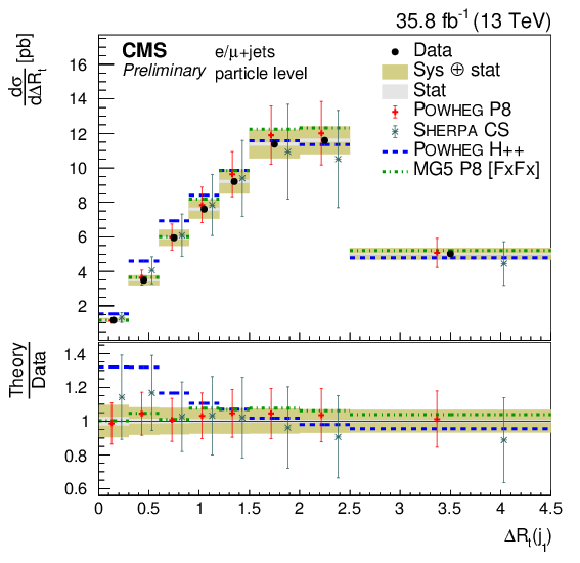
png pdf |
Figure 29-e:
Differential cross section at particle level as a function of nΔRt. The data are shown as points with light (dark) error bands indicating the statistical (statistical and systematic) uncertainties. The cross sections are compared to the predictions of POWHEG combined with PYTHIA8 (P8) or HERWIG++ (H++) and the multiparton simulations MG5_aMC@NLO (MG5)+PYTHIA8 FxFx and {sherpa}. The ratios of the predictions to the measured cross sections are shown at the bottom of each panel. |

png pdf |
Figure 29-f:
Differential cross section at particle level as a function of nΔRt. The data are shown as points with light (dark) error bands indicating the statistical (statistical and systematic) uncertainties. The cross sections are compared to the predictions of POWHEG combined with PYTHIA8 (P8) or HERWIG++ (H++) and the multiparton simulations MG5_aMC@NLO (MG5)+PYTHIA8 FxFx and {sherpa}. The ratios of the predictions to the measured cross sections are shown at the bottom of each panel. |

png pdf |
Figure 29-g:
Differential cross section at particle level as a function of nΔRt. The data are shown as points with light (dark) error bands indicating the statistical (statistical and systematic) uncertainties. The cross sections are compared to the predictions of POWHEG combined with PYTHIA8 (P8) or HERWIG++ (H++) and the multiparton simulations MG5_aMC@NLO (MG5)+PYTHIA8 FxFx and {sherpa}. The ratios of the predictions to the measured cross sections are shown at the bottom of each panel. |

png pdf |
Figure 29-h:
Differential cross section at particle level as a function of nΔRt. The data are shown as points with light (dark) error bands indicating the statistical (statistical and systematic) uncertainties. The cross sections are compared to the predictions of POWHEG combined with PYTHIA8 (P8) or HERWIG++ (H++) and the multiparton simulations MG5_aMC@NLO (MG5)+PYTHIA8 FxFx and {sherpa}. The ratios of the predictions to the measured cross sections are shown at the bottom of each panel. |
| Tables | |

png pdf |
Table 1:
Comparison between the measured distributions at parton level and the predictions of POWHEG combined with PYTHIA8 (P8) or HERWIG++ (H++), the multiparton simulation MG5_aMC@NLO FxFx, and the NNLO QCD+NLO EW calculations. The compatibility with the POWHEG+PYTHIA8 prediction is also calculated under consideration of its theoretical uncertainties (with unc.), while those are not taken into account for the other comparisons. The results of the χ2 tests are listed together with the numbers of degrees of freedom (dof) and the corresponding p-values. |

png pdf |
Table 2:
Comparison between the measured distributions at particle level and the predictions of POWHEG combined with PYTHIA8 (P8) or HERWIG++ (H++) and the multiparton simulations of MG5_aMC@NLO FxFx and {sherpa}. The compatibilities with the POWHEG+PYTHIA8 and the {sherpa} predictions are also calculated under consideration of their theoretical uncertainties (with unc.), while those are not taken into account for the other comparisons. The results of the χ2 tests are listed together with the numbers of degrees of freedom (dof) and the corresponding p-values. |

png pdf |
Table 3:
Comparison between the measurements involving multiplicities and kinematic properties of jets and the predictions of POWHEG combined with PYTHIA8 (P8) or HERWIG++ (H++) and the multiparton simulations of MG5_aMC@NLO FxFx and {sherpa}. The compatibilities with the POWHEG+PYTHIA8 and the {sherpa} predictions are also calculated under consideration of their theoretical uncertainties (with unc.), while those are not taken into account for the other comparisons. The results of the χ2 tests are listed together with the numbers of degrees of freedom (dof) and the corresponding p-values. |
| Summary |
|
Measurements of the differential and double-differential cross sections for tˉt production in pp collisions at 13 TeV have been presented. The data correspond to an integrated luminosity of 35.8 fb−1 recorded by the CMS experiment. The tˉt production cross section is measured in the ℓ+jets channels at particle and parton level channel as a function of transverse momentum pT and rapidity |y| of the top quarks; pT, |y|, and invariant mass of the tˉt system. In addition, at particle level detailed studies of multiplicities and kinematic properties of the jets in tˉt events have been performed. The dominant sources of uncertainty are the jet energy scale uncertainties on the experimental side and parton shower modeling on the theoretical side. The results are compared to several standard model predictions that use different methods and approximations for their calculations. The kinematic properties of the top quarks and the tˉt system are well described apart from a softer measured pT of the top quarks, which has already been observed in previous measurements and can partially be explained by calculations including NNLO QCD and NLO EW corrections. The kinematic distributions and multiplicities of the additional jets are reasonably modeled by POWHEG+PYTHIA. However, the POWHEG descriptions of additional jets rely on phenomenological models of parton showering and hadronization with tuned parameters. With the selected settings the SHERPA predictions show larger discrepancies from the data, but they strongly depend on the choice of scales. The multiparton simulation of MG5_aMC@NLO+PYTHIAA FxFx results in the best agreement with the measurements. |
| References | ||||
| 1 | CMS Collaboration | Cms luminosity measurement for the 2016 data taking period | CMS-PAS-LUM-17-001 | CMS-PAS-LUM-17-001 |
| 2 | CMS Collaboration | Measurement of differential top-quark pair production cross sections in pp colisions at √s= 7 TeV | EPJC 73 (2013) 2339 | CMS-TOP-11-013 1211.2220 |
| 3 | ATLAS Collaboration | Differential top-antitop cross-section measurements as a function of observables constructed from final-state particles using pp collisions at √s= 7 TeV in the ATLAS detector | JHEP 06 (2015) 100 | 1502.05923 |
| 4 | CMS Collaboration | Measurement of the differential cross section for top quark pair production in pp collisions at √s= 8 TeV | EPJC 75 (2015) 542 | CMS-TOP-12-028 1505.04480 |
| 5 | ATLAS Collaboration | Measurements of top-quark pair differential cross-sections in the lepton+jets channel in pp collisions at √s= 8 TeV using the ATLAS detector | EPJC 76 (2016) 538 | 1511.04716 |
| 6 | ATLAS Collaboration | Measurement of the differential cross-section of highly boosted top quarks as a function of their transverse momentum in √s= 8 TeV proton-proton collisions using the ATLAS detector | PRD 93 (2016) 032009 | 1510.03818 |
| 7 | CMS Collaboration | Measurement of the tˉt production cross section in the all-jets final state in pp collisions at √s= 8 TeV | EPJC 76 (2016) 128 | CMS-TOP-14-018 1509.06076 |
| 8 | CMS Collaboration | Measurement of the integrated and differential tˉt production cross sections for high-pT top quarks in pp collisions at √s= 8 TeV | PRD 94 (2016) 072002 | CMS-TOP-14-012 1605.00116 |
| 9 | CMS Collaboration | Measurement of the differential cross sections for top quark pair production as a function of kinematic event variables in pp collisions at √s= 7 and 8 TeV | PRD 94 (2016) 052006 | CMS-TOP-12-042 1607.00837 |
| 10 | CMS Collaboration | Measurement of t¯t production with additional jet activity, including b quark jets, in the dilepton decay channel using pp collisions at √s= 8 TeV | EPJC 76 (2016) 379 | CMS-TOP-12-041 1510.03072 |
| 11 | ATLAS Collaboration | Measurement of top quark pair differential cross-sections in the dilepton channel in pp collisions at √s= 7 and 8 TeV with ATLAS | PRD 94 (2016) 092003 | 1607.07281 |
| 12 | ATLAS Collaboration | Measurement of jet activity in top quark events using the eμ final state with two b-tagged jets in pp collisions at √s= 8 TeV with the ATLAS detector | JHEP 09 (2016) 074 | 1606.09490 |
| 13 | ATLAS Collaboration | Measurement of jet activity produced in top-quark events with an electron, a muon and two b-tagged jets in the final state in pp collisions at √s= 13 TeV with the ATLAS detector | EPJC 77 (2017) 220 | 1610.09978 |
| 14 | ATLAS Collaboration | Measurements of top-quark pair differential cross-sections in the eμ channel in pp collisions at √s= 13 TeV using the ATLAS detector | EPJC 77 (2017) 292 | 1612.05220 |
| 15 | CMS Collaboration | Measurement of differential cross sections for top quark pair production using the lepton+jets final state in proton-proton collisions at 13 TeV | PRD 95 (2017) 092001 | CMS-TOP-16-008 1610.04191 |
| 16 | P. Nason | A new method for combining NLO QCD with shower Monte Carlo algorithms | JHEP 11 (2004) 040 | hep-ph/0409146 |
| 17 | S. Frixione, P. Nason, and C. Oleari | Matching NLO QCD computations with Parton Shower simulations: the POWHEG method | JHEP 11 (2007) 070 | 0709.2092 |
| 18 | S. Alioli, P. Nason, C. Oleari, and E. Re | A general framework for implementing NLO calculations in shower Monte Carlo programs: the POWHEG BOX | JHEP 06 (2010) 043 | 1002.2581 |
| 19 | J. M. Campbell, R. K. Ellis, P. Nason, and E. Re | Top-pair production and decay at NLO matched with parton showers | JHEP 04 (2015) 114 | 1412.1828 |
| 20 | J. Alwall et al. | The automated computation of tree-level and next-to-leading order differential cross sections, and their matching to parton shower simulations | JHEP 07 (2014) 079 | 1405.0301 |
| 21 | T. Sjostrand, S. Mrenna, and P. Skands | PYTHIA 6.4 physics and manual | JHEP 05 (2006) 026 | hep-ph/0603175 |
| 22 | T. Sjostrand, S. Mrenna, and P. Z. Skands | A brief introduction to PYTHIA 8.1 | CPC 178 (2008) 852 | 0710.3820 |
| 23 | P. Skands, S. Carrazza, and J. Rojo | Tuning PYTHIA 8.1: the Monash 2013 Tune | EPJC 74 (2014) 3024 | 1404.5630 |
| 24 | R. Frederix and S. Frixione | Merging meets matching in MC@NLO | JHEP 12 (2012) 061 | 1209.6215 |
| 25 | NNPDF Collaboration | Parton distributions for the LHC Run II | JHEP 04 (2015) 040 | 1410.8849 |
| 26 | M. Czakon and A. Mitov | Top++: A Program for the Calculation of the Top-Pair Cross-Section at Hadron Colliders | CPC 185 (2014) 2930 | 1112.5675 |
| 27 | M. Bahr et al. | Herwig++ physics and manual | EPJC 58 (2008) 639 | 0803.0883 |
| 28 | M. H. Seymour and A. Siodmok | Constraining MPI models using σeff and recent Tevatron and LHC Underlying Event data | JHEP 10 (2013) 113 | 1307.5015 |
| 29 | E. Re | Single-top Wt-channel production matched with parton showers using the POWHEG method | EPJC 71 (2011) 1547 | 1009.2450 |
| 30 | Y. Li and F. Petriello | Combining QCD and electroweak corrections to dilepton production in FEWZ | PRD 86 (2012) 094034 | 1208.5967 |
| 31 | P. Kant et al. | HatHor for single top-quark production: Updated predictions and uncertainty estimates for single top-quark production in hadronic collisions | CPC 191 (2015) 74 | 1406.4403 |
| 32 | N. Kidonakis | NNLL threshold resummation for top-pair and single-top production | Phys. Part. Nucl. 45 (2014) 714 | 1210.7813 |
| 33 | J. Allison et al. | Geant4 developments and applications | IEEE Trans. Nucl. Sci. 53 (2006) 270 | |
| 34 | CMS Collaboration | Object definitions for top quark analyses at the particle level | CDS | |
| 35 | M. Cacciari, G. P. Salam, and G. Soyez | The anti-kt jet clustering algorithm | JHEP 04 (2008) 063 | 0802.1189 |
| 36 | M. Cacciari, G. P. Salam, and G. Soyez | FastJet user manual | EPJC 72 (2012) 1896 | 1111.6097 |
| 37 | CMS Collaboration | Performance of CMS muon reconstruction in pp collision events at √s= 7 TeV | JINST 7 (2012) P10002 | CMS-MUO-10-004 1206.4071 |
| 38 | M. Cacciari and G. P. Salam | Pileup subtraction using jet areas | PLB 659 (2008) 119 | 0707.1378 |
| 39 | CMS Collaboration | Performance of electron reconstruction and selection with the CMS detector in proton-proton collisions at √s= 8 TeV | JINST 10 (2015) P06005 | CMS-EGM-13-001 1502.02701 |
| 40 | CMS Collaboration | Jet energy scale and resolution in the CMS experiment in pp collisions at 8 TeV | JINST 12 (2017) P02014 | CMS-JME-13-004 1607.03663 |
| 41 | CMS Collaboration | Identification of b quark jets at the CMS Experiment in the LHC Run 2 | CMS-PAS-BTV-15-001 | CMS-PAS-BTV-15-001 |
| 42 | B. A. Betchart, R. Demina, and A. Harel | Analytic solutions for neutrino momenta in decay of top quarks | NIMA 736 (2014) 169 | 1305.1878 |
| 43 | G. D'Agostini | A multidimensional unfolding method based on Bayes' theorem | NIMA 362 (1995) 487 | |
| 44 | CMS Collaboration | Investigations of the impact of the parton shower tuning in Pythia 8 in the modelling of t¯t at √s= 8 and 13 TeV | CMS-PAS-TOP-16-021 | CMS-PAS-TOP-16-021 |
| 45 | Particle Data Group Collaboration | Review of Particle Physics | CPC 38 (2014) 090001 | |
| 46 | M. Czakon et al. | Top-pair production at the LHC through NNLO QCD and NLO EW | 1705.04105 | |
| 47 | A. Manohar, P. Nason, G. P. Salam, and G. Zanderighi | How bright is the proton? A precise determination of the photon parton distribution function | PRL 117 (2016), no. 24, 242002 | 1607.04266 |
| 48 | T. Gleisberg et al. | Event generation with SHERPA 1.1 | JHEP 02 (2009) 007 | 0811.4622 |
| 49 | F. Cascioli, P. Maierhofer, and S. Pozzorini | Scattering amplitudes with open loops | PRL 108 (Mar, 2012) 111601 | |
| 50 | S. Schumann and F. Krauss | A Parton shower algorithm based on Catani-Seymour dipole factorisation | JHEP 03 (2008) 038 | 0709.1027 |

|
Compact Muon Solenoid LHC, CERN |

|

|

|

|

|

|